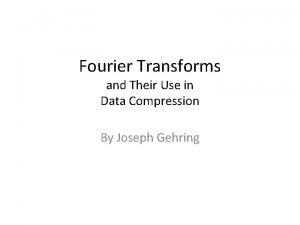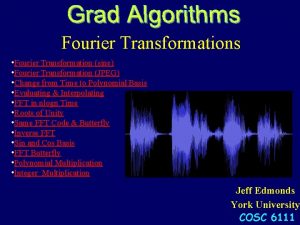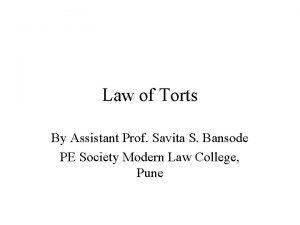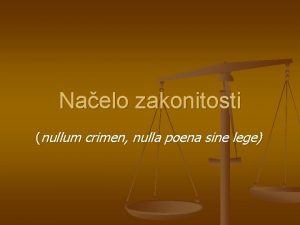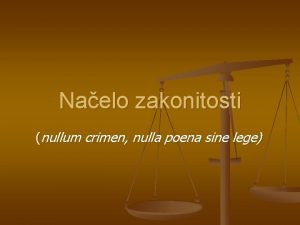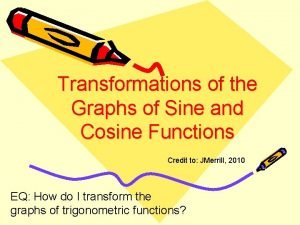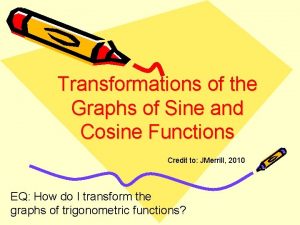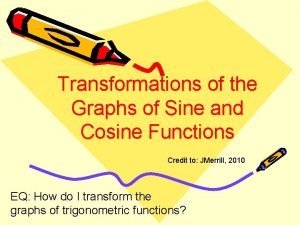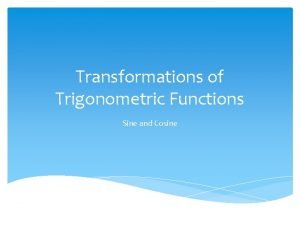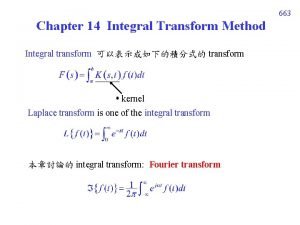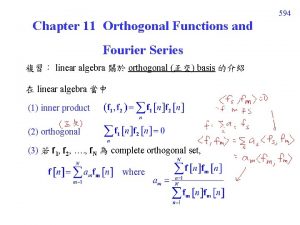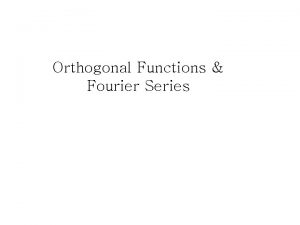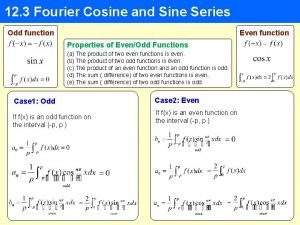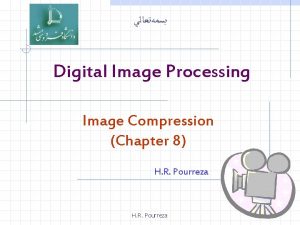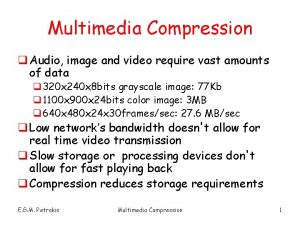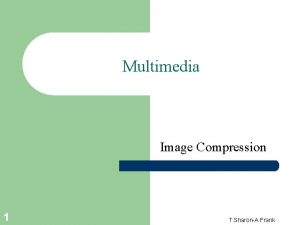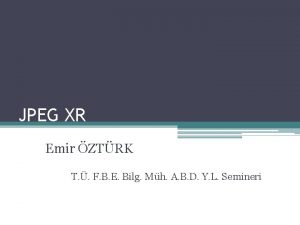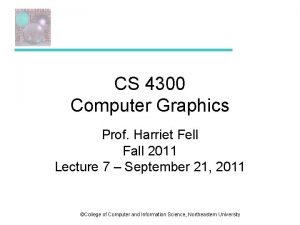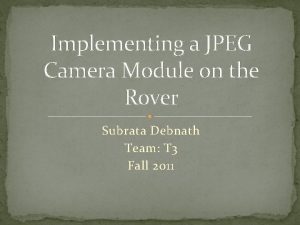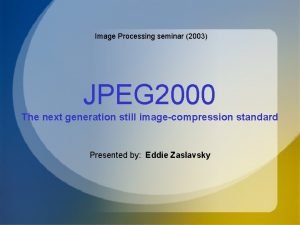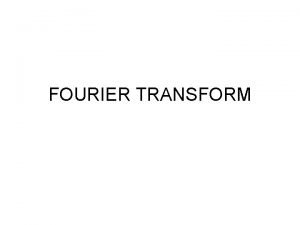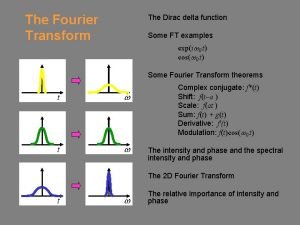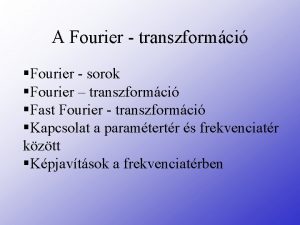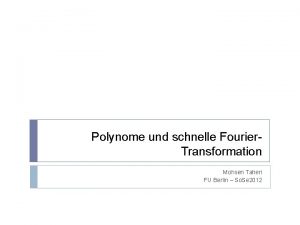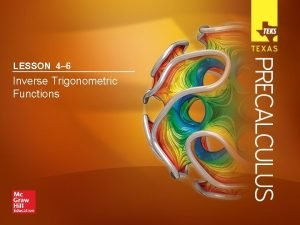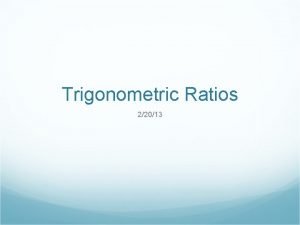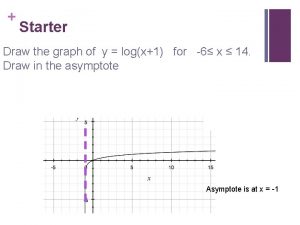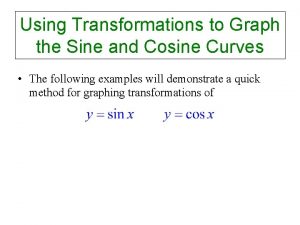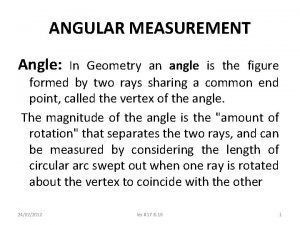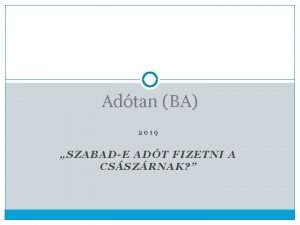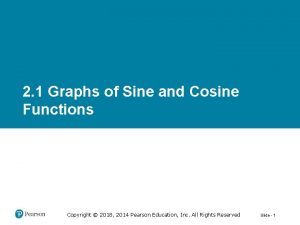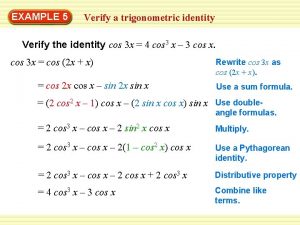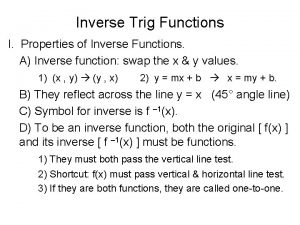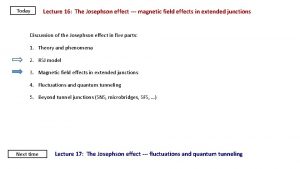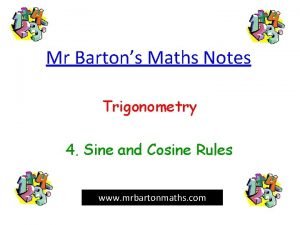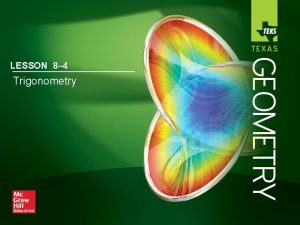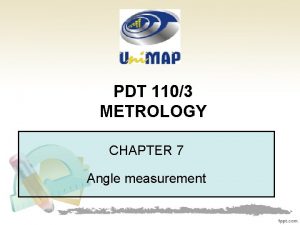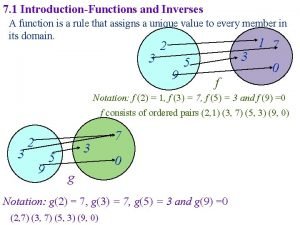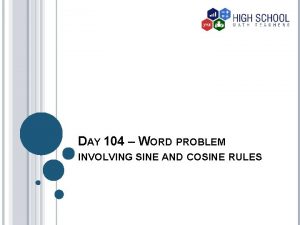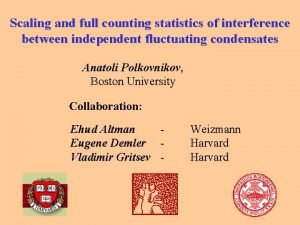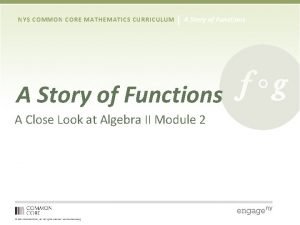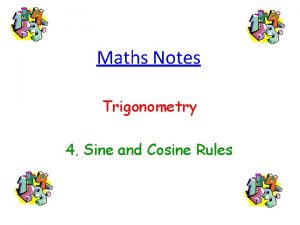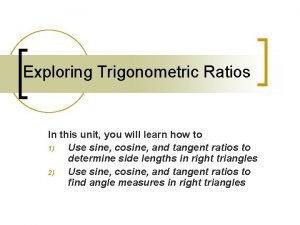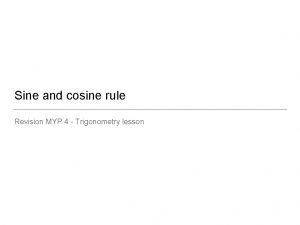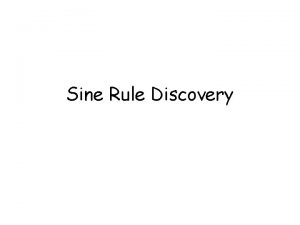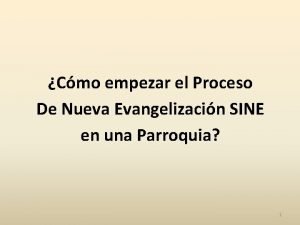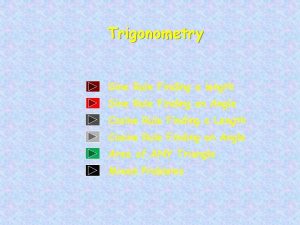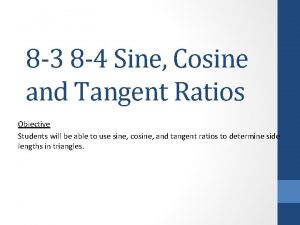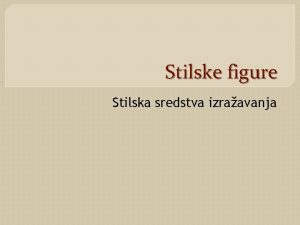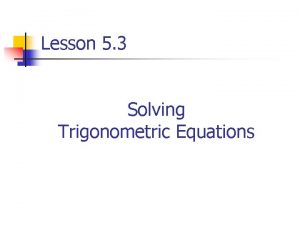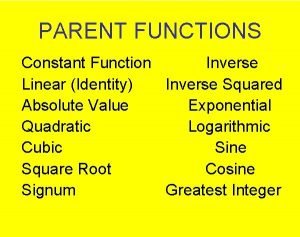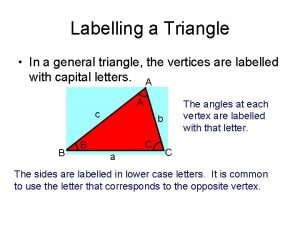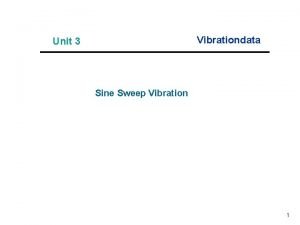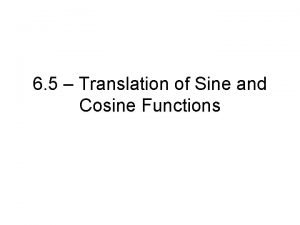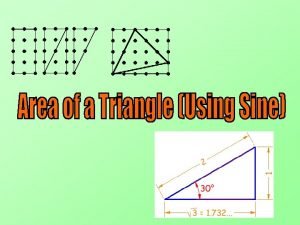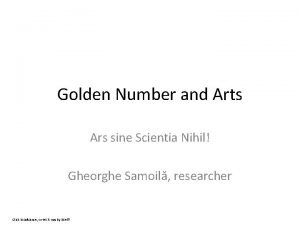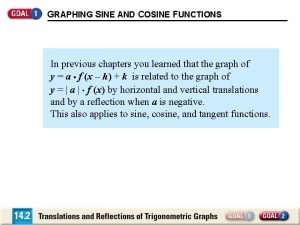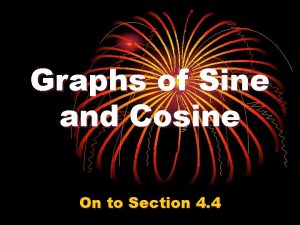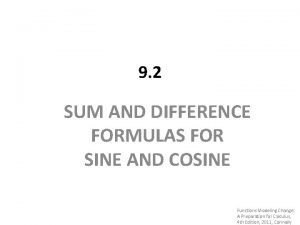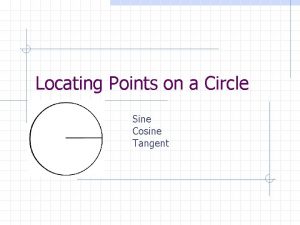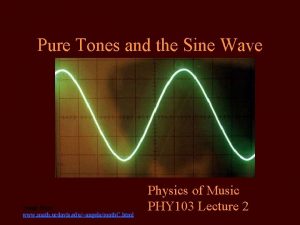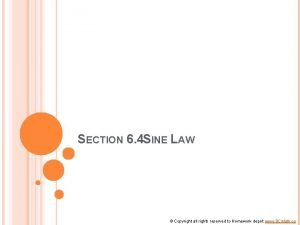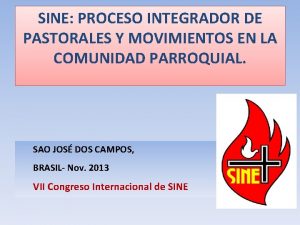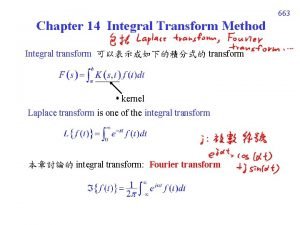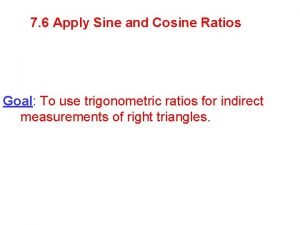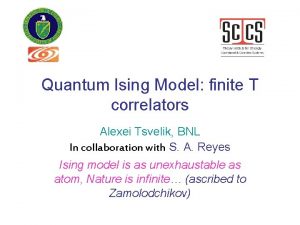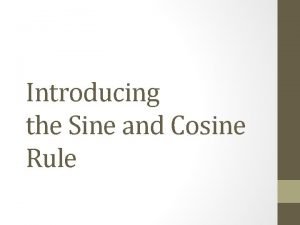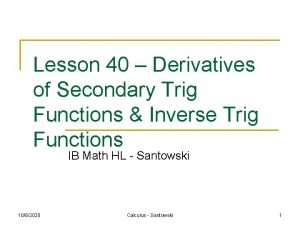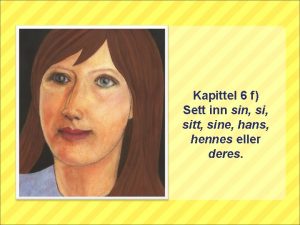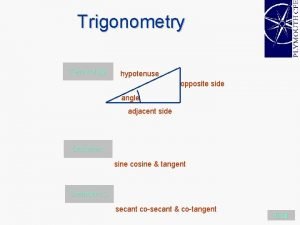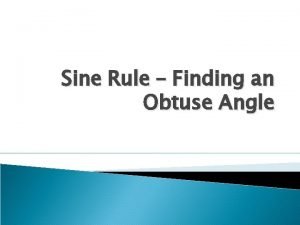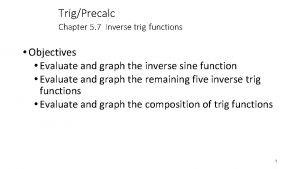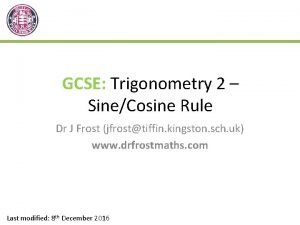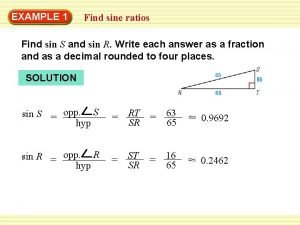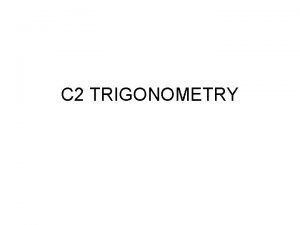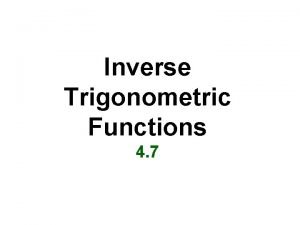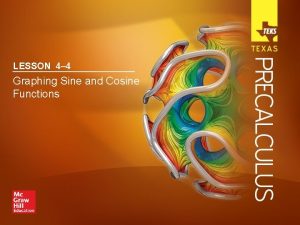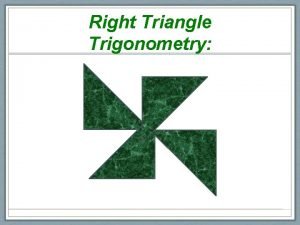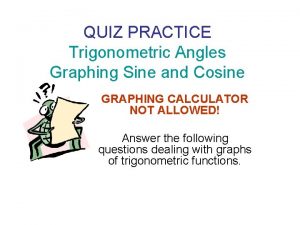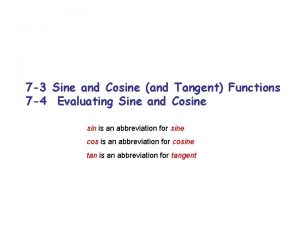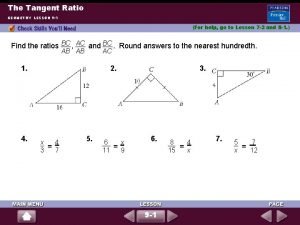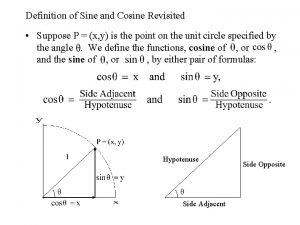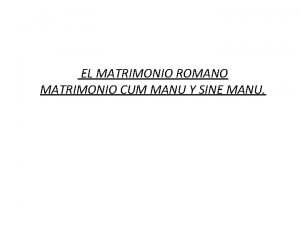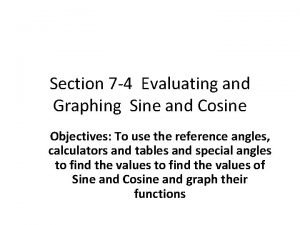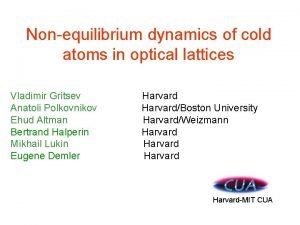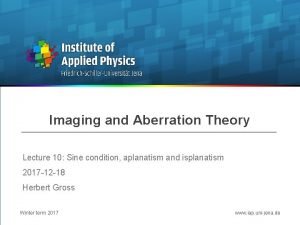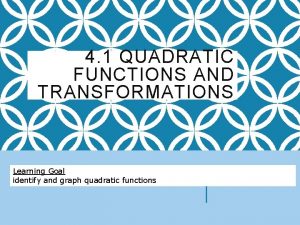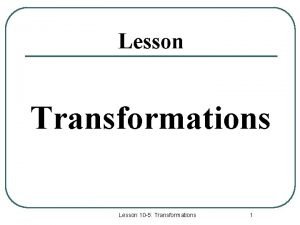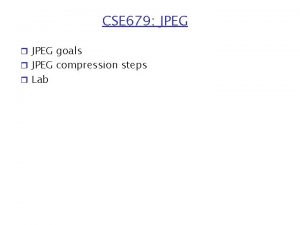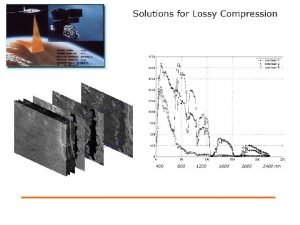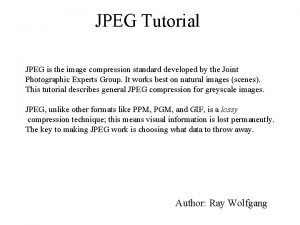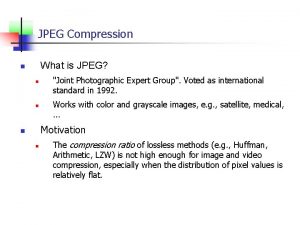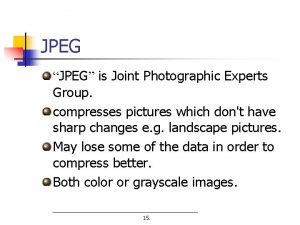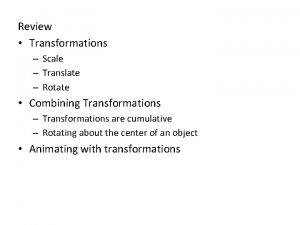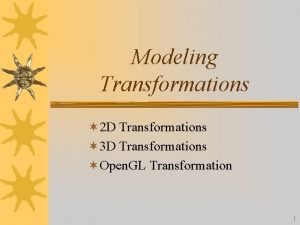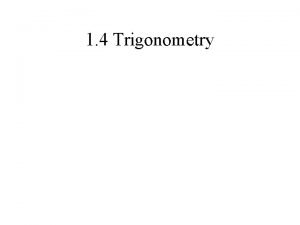Fourier Transformations Fourier Transformation sine Fourier Transformation JPEG


![Changing Basis Change of Basis: T([a 1, a 2, …, ad]) = [A 1, Changing Basis Change of Basis: T([a 1, a 2, …, ad]) = [A 1,](https://slidetodoc.com/presentation_image/3d0915b09fc5df4b1df93bf40a0d3a62/image-3.jpg)
![Changing Basis Change of Basis: T([a 1, a 2, …, ad]) = [A 1, Changing Basis Change of Basis: T([a 1, a 2, …, ad]) = [A 1,](https://slidetodoc.com/presentation_image/3d0915b09fc5df4b1df93bf40a0d3a62/image-4.jpg)
![Changing Basis Change of Basis: T([a 1, a 2, …, ad]) = [A 1, Changing Basis Change of Basis: T([a 1, a 2, …, ad]) = [A 1,](https://slidetodoc.com/presentation_image/3d0915b09fc5df4b1df93bf40a0d3a62/image-5.jpg)
![Changing Basis Change of Basis: T([a 1, a 2, …, ad]) = [A 1, Changing Basis Change of Basis: T([a 1, a 2, …, ad]) = [A 1,](https://slidetodoc.com/presentation_image/3d0915b09fc5df4b1df93bf40a0d3a62/image-6.jpg)
![Changing Basis Change of Basis: T([a 1, a 2, …, ad]) = [A 1, Changing Basis Change of Basis: T([a 1, a 2, …, ad]) = [A 1,](https://slidetodoc.com/presentation_image/3d0915b09fc5df4b1df93bf40a0d3a62/image-7.jpg)
![Changing Basis Change of Basis: T([a 1, a 2, …, ad]) = [A 1, Changing Basis Change of Basis: T([a 1, a 2, …, ad]) = [A 1,](https://slidetodoc.com/presentation_image/3d0915b09fc5df4b1df93bf40a0d3a62/image-8.jpg)
![Changing Basis Change of Basis: T([a 1, a 2, …, ad]) = [A 1, Changing Basis Change of Basis: T([a 1, a 2, …, ad]) = [A 1,](https://slidetodoc.com/presentation_image/3d0915b09fc5df4b1df93bf40a0d3a62/image-9.jpg)
![Changing Basis Change of Basis: T([a 1, a 2, …, ad]) = [A 1, Changing Basis Change of Basis: T([a 1, a 2, …, ad]) = [A 1,](https://slidetodoc.com/presentation_image/3d0915b09fc5df4b1df93bf40a0d3a62/image-10.jpg)
![Changing Basis Change of Basis: T([a 1, a 2, …, ad]) = [A 1, Changing Basis Change of Basis: T([a 1, a 2, …, ad]) = [A 1,](https://slidetodoc.com/presentation_image/3d0915b09fc5df4b1df93bf40a0d3a62/image-11.jpg)




![Fourier Transformation Time Domain y The value y[j] of the signal at each point Fourier Transformation Time Domain y The value y[j] of the signal at each point](https://slidetodoc.com/presentation_image/3d0915b09fc5df4b1df93bf40a0d3a62/image-16.jpg)
![Fourier Transformation Change of Basis: T([a 1, a 2, …, ad]) = [A 1, Fourier Transformation Change of Basis: T([a 1, a 2, …, ad]) = [A 1,](https://slidetodoc.com/presentation_image/3d0915b09fc5df4b1df93bf40a0d3a62/image-17.jpg)
![Fourier Transformation Change of Basis: T(y[0], y[1], …, y[n-1]) = [YRe[0], …, YIm[n/2]] Changes Fourier Transformation Change of Basis: T(y[0], y[1], …, y[n-1]) = [YRe[0], …, YIm[n/2]] Changes](https://slidetodoc.com/presentation_image/3d0915b09fc5df4b1df93bf40a0d3a62/image-18.jpg)
![Fourier Transformation Change of Basis: T(y[0], y[1], …, y[n-1]) = [YRe[0], …, YIm[n/2]] Changes Fourier Transformation Change of Basis: T(y[0], y[1], …, y[n-1]) = [YRe[0], …, YIm[n/2]] Changes](https://slidetodoc.com/presentation_image/3d0915b09fc5df4b1df93bf40a0d3a62/image-19.jpg)
![Fourier Transformation Change of Basis: T(y[0], y[1], …, y[n-1]) = [YRe[0], …, YIm[n/2]] Changes Fourier Transformation Change of Basis: T(y[0], y[1], …, y[n-1]) = [YRe[0], …, YIm[n/2]] Changes](https://slidetodoc.com/presentation_image/3d0915b09fc5df4b1df93bf40a0d3a62/image-20.jpg)
![Fourier Transformation Time Basis =[I 1, I 2, …] =[ , ] Orthogonal Basis Fourier Transformation Time Basis =[I 1, I 2, …] =[ , ] Orthogonal Basis](https://slidetodoc.com/presentation_image/3d0915b09fc5df4b1df93bf40a0d3a62/image-21.jpg)
![Fourier Transformation Time Basis 2/ n [ [ s 1[1] s 2[1] s 1[2] Fourier Transformation Time Basis 2/ n [ [ s 1[1] s 2[1] s 1[2]](https://slidetodoc.com/presentation_image/3d0915b09fc5df4b1df93bf40a0d3a62/image-22.jpg)
![Fourier Transformation Time Domain y Frequency Domain Y Cosine with f=4 Impulse at Yre[4] Fourier Transformation Time Domain y Frequency Domain Y Cosine with f=4 Impulse at Yre[4]](https://slidetodoc.com/presentation_image/3d0915b09fc5df4b1df93bf40a0d3a62/image-23.jpg)








![Fourier Transformation h[] = h[] In order understand This response h[] this transformation, we Fourier Transformation h[] = h[] In order understand This response h[] this transformation, we](https://slidetodoc.com/presentation_image/3d0915b09fc5df4b1df93bf40a0d3a62/image-32.jpg)
![Fourier Transformation h[] = x[] = h[] Feed in any signal Computationally trying to Fourier Transformation h[] = x[] = h[] Feed in any signal Computationally trying to](https://slidetodoc.com/presentation_image/3d0915b09fc5df4b1df93bf40a0d3a62/image-33.jpg)
![Fourier Transformation Time Domain y Frequency Domain Y Impulse Response h[] = H[] Input Fourier Transformation Time Domain y Frequency Domain Y Impulse Response h[] = H[] Input](https://slidetodoc.com/presentation_image/3d0915b09fc5df4b1df93bf40a0d3a62/image-34.jpg)
![Fourier Transformation Time Domain y Impulse Response h[] = * Convolution Frequency Domain Y Fourier Transformation Time Domain y Impulse Response h[] = * Convolution Frequency Domain Y](https://slidetodoc.com/presentation_image/3d0915b09fc5df4b1df93bf40a0d3a62/image-35.jpg)















![Fourier Transformation Polynomial Basis Change of Basis: T([y[0], y[1], …, y[n-1]]) = [a 1, Fourier Transformation Polynomial Basis Change of Basis: T([y[0], y[1], …, y[n-1]]) = [a 1,](https://slidetodoc.com/presentation_image/3d0915b09fc5df4b1df93bf40a0d3a62/image-51.jpg)
![Fourier Transformation Polynomial Basis Change of Basis: T([y[0], y[1], …, y[n-1]]) = [a 1, Fourier Transformation Polynomial Basis Change of Basis: T([y[0], y[1], …, y[n-1]]) = [a 1,](https://slidetodoc.com/presentation_image/3d0915b09fc5df4b1df93bf40a0d3a62/image-52.jpg)























































































![Algorithm FFT (Re. X, Im. X) Input: Re. X[ ], Im. X[ ] = Algorithm FFT (Re. X, Im. X) Input: Re. X[ ], Im. X[ ] =](https://slidetodoc.com/presentation_image/3d0915b09fc5df4b1df93bf40a0d3a62/image-140.jpg)




 in time O(n). [g×f](x) = cn-1 xn-1 Multiplying Big Integers • Evaluate [g×f](2 m) in time O(n). [g×f](x) = cn-1 xn-1](https://slidetodoc.com/presentation_image/3d0915b09fc5df4b1df93bf40a0d3a62/image-145.jpg)
 in time O(n). [g×f](x) = cnxn + Multiplying Big Integers • Evaluate [g×f](2 m) in time O(n). [g×f](x) = cnxn +](https://slidetodoc.com/presentation_image/3d0915b09fc5df4b1df93bf40a0d3a62/image-146.jpg)
 in time O(n). [g×f](x) = cnxn + Multiplying Big Integers • Evaluate [g×f](2 m) in time O(n). [g×f](x) = cnxn +](https://slidetodoc.com/presentation_image/3d0915b09fc5df4b1df93bf40a0d3a62/image-147.jpg)



- Slides: 150

Fourier Transformations • Fourier Transformation (sine) • Fourier Transformation (JPEG) • Change from Time to Polynomial Basis • Evaluating & Interpolating • FFT in nlogn Time • Roots of Unity • Same FFT Code & Butterfly • Inverse FFT • Sin and Cos Basis • FFT Butterfly • Polynomial Multiplication • Integer Multiplication Jeff Edmonds York University COSC 6111

Sum of sine waves gives a square wave.
![Changing Basis Change of Basis Ta 1 a 2 ad A 1 Changing Basis Change of Basis: T([a 1, a 2, …, ad]) = [A 1,](https://slidetodoc.com/presentation_image/3d0915b09fc5df4b1df93bf40a0d3a62/image-3.jpg)
Changing Basis Change of Basis: T([a 1, a 2, …, ad]) = [A 1, A 2, …, Ad] Changes the basis used to describe an object. • The standard basis of a vector space: • A tuple <w 1, w 2, …, wd> of basis objects • Linearly independent • Spans the space uniquely "v $[a 1, a 2, …, ad], v = a 1 w 1+a 2 w 2 +… + adwd • The new basis of a vector space: • A tuple <W 1, W 2, …, Wd> of basis objects • Linearly independent • Spans the space uniquely "v $[A 1, A 2, …, Ad], v = A 1 W 1+A 2 W 2 +… + Ad. Wd • Use small letters aj for the coefficients in the standard basis and capital letters Ak for the coefficients in the new basis
![Changing Basis Change of Basis Ta 1 a 2 ad A 1 Changing Basis Change of Basis: T([a 1, a 2, …, ad]) = [A 1,](https://slidetodoc.com/presentation_image/3d0915b09fc5df4b1df93bf40a0d3a62/image-4.jpg)
Changing Basis Change of Basis: T([a 1, a 2, …, ad]) = [A 1, A 2, …, Ad] Changes the basis used to describe an object. "v $[a 1, a 2, …, ad], v = a 1 w 1 +a 2 w 2 +… + adwd "v $[A 1, A 2, …, Ad], v = A 1 W 1+A 2 W 2 +… + Ad. Wd Standard =[w , w ] New 1 2 =[W 1, W 2] Basis =[ , ] v= v= [A 1, A 2] = [11/5, 32/5] [a 1, a 2] = [3, 2] T-1([A 1, A 2, …, Ad]) = [a 1, a 2, …, ad] [ ? ? ][ ] =[ ] A 1 A 2 a 1 a 2
![Changing Basis Change of Basis Ta 1 a 2 ad A 1 Changing Basis Change of Basis: T([a 1, a 2, …, ad]) = [A 1,](https://slidetodoc.com/presentation_image/3d0915b09fc5df4b1df93bf40a0d3a62/image-5.jpg)
Changing Basis Change of Basis: T([a 1, a 2, …, ad]) = [A 1, A 2, …, Ad] Changes the basis used to describe an object. "v $[a 1, a 2, …, ad], v = a 1 w 1 +a 2 w 2 +… + adwd "v $[A 1, A 2, …, Ad], v = A 1 W 1+A 2 W 2 +… + Ad. Wd Standard =[w , w ] New 1 2 =[W 1, W 2] Basis =[ , ] v 3/ = 5 W 1[2] 4/ 5 W 1[1] [a 1, a 2] = [4/5, -3/5] [A 1, A 2] = [1, 0] T-1([A 1, A 2, …, Ad]) = [a 1, a 2, …, ad] [ 4? / 5 ? -3? /5 ? ][ ] =[ ] [ A 11 A 02 4/ a 51 -3 a/25 W 1[1] W 1[2] ? ? ][ ] =[ ] 1 0 W 1[1] W 1[2]
![Changing Basis Change of Basis Ta 1 a 2 ad A 1 Changing Basis Change of Basis: T([a 1, a 2, …, ad]) = [A 1,](https://slidetodoc.com/presentation_image/3d0915b09fc5df4b1df93bf40a0d3a62/image-6.jpg)
Changing Basis Change of Basis: T([a 1, a 2, …, ad]) = [A 1, A 2, …, Ad] Changes the basis used to describe an object. "v $[a 1, a 2, …, ad], v = a 1 w 1 +a 2 w 2 +… + adwd "v $[A 1, A 2, …, Ad], v = A 1 W 1+A 2 W 2 +… + Ad. Wd Standard =[w , w ] New 1 2 =[W 1, W 2] Basis =[ , ] v= 4/ 3/ 5 W 2[2] 5 W 2[1] [a 1, a 2] = [3/5, 4/5] [A 1, A 2] = [0, 1] T-1([A 1, A 2, …, Ad]) = [a 1, a 2, …, ad] [ 4/ 5 -3 / 5 3? /5 4/ ? 5 ][ ] =[ ] [ A 01 A 12 3 a/ 15 4 a/ 25 ][ ] =[ ] W 1[1] W 2? [1] W 1[2] W 2? [2] 0 1 W 1[1] W 1[2]
![Changing Basis Change of Basis Ta 1 a 2 ad A 1 Changing Basis Change of Basis: T([a 1, a 2, …, ad]) = [A 1,](https://slidetodoc.com/presentation_image/3d0915b09fc5df4b1df93bf40a0d3a62/image-7.jpg)
Changing Basis Change of Basis: T([a 1, a 2, …, ad]) = [A 1, A 2, …, Ad] Changes the basis used to describe an object. "v $[a 1, a 2, …, ad], v = a 1 w 1 +a 2 w 2 +… + adwd "v $[A 1, A 2, …, Ad], v = A 1 W 1+A 2 W 2 +… + Ad. Wd Standard =[w , w ] New 1 2 =[W 1, W 2] Basis =[ , ] v= v= [A 1, A 2] = [11/5, 32/5] [a 1, a 2] = [3, 2] T-1([A 1, A 2, …, Ad]) = [a 1, a 2, …, ad] [ 4/ 5 -3 / 5 3/ 5 4/ 5 ][ ] =[ ] [ 1 A 1/15 3 A 2/25 a 31 a 22 ][ ] =[ ] W 1[1] W 2[1] W 1[2] W 2[2] A 1 A 2 a 1 a 2
![Changing Basis Change of Basis Ta 1 a 2 ad A 1 Changing Basis Change of Basis: T([a 1, a 2, …, ad]) = [A 1,](https://slidetodoc.com/presentation_image/3d0915b09fc5df4b1df93bf40a0d3a62/image-8.jpg)
Changing Basis Change of Basis: T([a 1, a 2, …, ad]) = [A 1, A 2, …, Ad] Changes the basis used to describe an object. "v $[a 1, a 2, …, ad], v = a 1 w 1 +a 2 w 2 +… + adwd "v $[A 1, A 2, …, Ad], v = A 1 W 1+A 2 W 2 +… + Ad. Wd Standard =[w , w ] New 1 2 =[W 1, W 2] Basis =[ , ] =[W 1[2] , W 2[2] [ [ W 1[1] W [1] 2 ][ ] =[ ] ] [ ] =[ ] W 1[1] W 2[1] W 1[2] W 2[2] -1 A 2 a 1 a 2 A 1 A 2 ]
![Changing Basis Change of Basis Ta 1 a 2 ad A 1 Changing Basis Change of Basis: T([a 1, a 2, …, ad]) = [A 1,](https://slidetodoc.com/presentation_image/3d0915b09fc5df4b1df93bf40a0d3a62/image-9.jpg)
Changing Basis Change of Basis: T([a 1, a 2, …, ad]) = [A 1, A 2, …, Ad] Changes the basis used to describe an object. "v $[a 1, a 2, …, ad], v = a 1 w 1 +a 2 w 2 +… + adwd "v $[A 1, A 2, …, Ad], v = A 1 W 1+A 2 W 2 +… + Ad. Wd Standard =[w , w ] New 1 2 =[W 1, W 2] Basis =[ , ] =[W 1[2] , W 2[2] W 1[1] W [1] 2 ] If the new basis vectors are orthogonal and of uniform length: • |W 1|2=n, then W 1∙W 1 = j. W 1[j] = n • W 1 W 2, then W 1∙W 2 = j. W 1[j] W 2[j] = 0 [ [ ][ ] ]= [ ] W 1[1]W 2[1] W 1[2] n 0 W 1[2]W 2[2] W 2[1] W 2[2] 0 n -1 W 1[1] W 1[2] W 1[1] W 2[1] 1/ = n W 2[1] W 2[2] W 1[2] W 2[2]
![Changing Basis Change of Basis Ta 1 a 2 ad A 1 Changing Basis Change of Basis: T([a 1, a 2, …, ad]) = [A 1,](https://slidetodoc.com/presentation_image/3d0915b09fc5df4b1df93bf40a0d3a62/image-10.jpg)
Changing Basis Change of Basis: T([a 1, a 2, …, ad]) = [A 1, A 2, …, Ad] Changes the basis used to describe an object. "v $[a 1, a 2, …, ad], v = a 1 w 1 +a 2 w 2 +… + adwd "v $[A 1, A 2, …, Ad], v = A 1 W 1+A 2 W 2 +… + Ad. Wd Standard =[w , w ] New 1 2 =[W 1, W 2] Basis =[ , ] =[W 1[2] , W 2[2] [ [ /[ ][ ] =[ ] ][ ] =[ ] W 1[1] W 2[1] W 1[2] W 2[2] 1 W 1[1] W [1] 2 W 1[1] W 1[2] n W 2[1] W 2[2] -1 A 2 a 1 a 2 A 1 A 2 ]
![Changing Basis Change of Basis Ta 1 a 2 ad A 1 Changing Basis Change of Basis: T([a 1, a 2, …, ad]) = [A 1,](https://slidetodoc.com/presentation_image/3d0915b09fc5df4b1df93bf40a0d3a62/image-11.jpg)
Changing Basis Change of Basis: T([a 1, a 2, …, ad]) = [A 1, A 2, …, Ad] Changes the basis used to describe an object. "v $[a 1, a 2, …, ad], v = a 1 w 1 +a 2 w 2 +… + adwd "v $[A 1, A 2, …, Ad], v = A 1 W 1+A 2 W 2 +… + Ad. Wd Standard =[w , w ] New 1 2 =[W 1, W 2] Basis =[ , ] =[W 1[2] , W 2[2] ] W 1[1] W [1] 2 Viewed a different way: v v v a 2 a 1 [ W 1 ][ ] =[ ] W 1[1] W 1[2] W 2[1] W 2[2] a 1 a 2 A 1 A 2 v∙W cos( ) = |v| |W 1 | 1 A 1 = |v| cos( ) |W | 1 = v∙W 1 = j aj W 1[j] This is the correlation between v and W 1

Fourier Transformation Fourier Transform • are a change of basis from the time basis to • sine/cosine basis Amazingly once you include • JPG complex numbers, • or polynomial basis the FFT code • Applications for sine/cosines and for polynomials • Signal Processing are the SAME. • Compressing data (eg images with. jpg) • Multiplying integers in n loglogn time. • …. Purposes: • Some operations on the data are cheaper in new format • Some concepts are easier to read from the data in new format • Some of the bits of the data in the new format are less significant and hence can be dropped. The Scientist and Engineer's Guide to Digital Signal Processing By Steven W. Smith, Ph. D. http: //www. dspguide. com/ch 8. htm

Fourier Transformation Sine &Cosine Basis y(t) A continuous periodic function t time Find the contribution of each frequency Swings, capacitors, and inductors all resonate at a given frequency, If this is the dominate musical note which is how the circuit picks out of frequency = 2 /T, the contribution of a given frequency. then all the other basis functions are its harmonics frequencies: , Frequency: Note on the Piano: C 2 , 3 , 4 , 5 , 6 , C G C E G . . .

Fourier Transformation Sine &Cosine Basis y(x) = x Surely this can’t be expressed as sum of sines and cosines. y(x) 2 sin(x) - sin(2 x) + 2/3 sin(3 x)

Fourier Transformation Sine &Cosine Basis y(x) = x 2 y(x) -4 sin(x) + sin(2 x) - 4/9 sin(3 x)
![Fourier Transformation Time Domain y The value yj of the signal at each point Fourier Transformation Time Domain y The value y[j] of the signal at each point](https://slidetodoc.com/presentation_image/3d0915b09fc5df4b1df93bf40a0d3a62/image-16.jpg)
Fourier Transformation Time Domain y The value y[j] of the signal at each point in time j. Frequency Domain Y The amount Y[f] of frequency f in the signal for each frequency f.
![Fourier Transformation Change of Basis Ta 1 a 2 ad A 1 Fourier Transformation Change of Basis: T([a 1, a 2, …, ad]) = [A 1,](https://slidetodoc.com/presentation_image/3d0915b09fc5df4b1df93bf40a0d3a62/image-17.jpg)
Fourier Transformation Change of Basis: T([a 1, a 2, …, ad]) = [A 1, A 2, …, Ad] Changes the basis used to describe an object. • The Time basis of a vector space: • A tuple <w 1, w 2, …, wd> of basis objects • Linearly independent • Spans the space uniquely "v $[a 1, a 2, …, ad], v = a 1 w 1+a 2 w 2 +… + adwd • The Fourier basis of a vector space: • A tuple <W 1, W 2, …, Wd> of basis objects • Linearly independent • Spans the space uniquely "v $[A 1, A 2, …, Ad], v = A 1 W 1+A 2 W 2 +… + Ad. Wd
![Fourier Transformation Change of Basis Ty0 y1 yn1 YRe0 YImn2 Changes Fourier Transformation Change of Basis: T(y[0], y[1], …, y[n-1]) = [YRe[0], …, YIm[n/2]] Changes](https://slidetodoc.com/presentation_image/3d0915b09fc5df4b1df93bf40a0d3a62/image-18.jpg)
Fourier Transformation Change of Basis: T(y[0], y[1], …, y[n-1]) = [YRe[0], …, YIm[n/2]] Changes the basis used to describe an object. "y $[y[0], y[1], …, y[n-1]], y = y[0]I 1 +y[1]I 2 +… + y[n-1]In Time Basis The time basis =[I 1, I 2, …] =[ , ] Ij[j’] one zero j j’ y= y[1]=2 The value y[j] of the signal at each point in time j. y[0]=3 A discrete periodic function y[j] j
![Fourier Transformation Change of Basis Ty0 y1 yn1 YRe0 YImn2 Changes Fourier Transformation Change of Basis: T(y[0], y[1], …, y[n-1]) = [YRe[0], …, YIm[n/2]] Changes](https://slidetodoc.com/presentation_image/3d0915b09fc5df4b1df93bf40a0d3a62/image-19.jpg)
Fourier Transformation Change of Basis: T(y[0], y[1], …, y[n-1]) = [YRe[0], …, YIm[n/2]] Changes the basis used to describe an object. "y $[y[0], y[1], …, y[n-1]], y = y[0]I 1 +y[1]I 2 +… + y[n-1]In y = YRe[0]∙c 1+YIm[0]∙s 1+ , …, YRe[n/2]∙sn/2+YIm[n/2]∙sn/2 Time =[I , …] Fourier=[? , ? ] =[c 1, s 1, . . ] 1 2 Basis c 1 s 1 =[ , ] y= y= y[1]=2 y[0]=3 YRe[0] =11/5 YIm[0] =32/5 cn/2 The amount Y[f] of frequency f in the signal for each frequency f. A discrete periodic function y[j] j sn/2
![Fourier Transformation Change of Basis Ty0 y1 yn1 YRe0 YImn2 Changes Fourier Transformation Change of Basis: T(y[0], y[1], …, y[n-1]) = [YRe[0], …, YIm[n/2]] Changes](https://slidetodoc.com/presentation_image/3d0915b09fc5df4b1df93bf40a0d3a62/image-20.jpg)
Fourier Transformation Change of Basis: T(y[0], y[1], …, y[n-1]) = [YRe[0], …, YIm[n/2]] Changes the basis used to describe an object. "y $[y[0], y[1], …, y[n-1]], y = y[0]I 1 +y[1]I 2 +… + y[n-1]In y = YRe[0]∙c 1+YIm[0]∙s 1+ , …, YRe[n/2]∙sn/2+YIm[n/2]∙sn/2 Time =[I , …] Fourier=[c , s , . . ] 1 2 1 1 Basis c 1 s 1 =[ , ] y= y[1]=2 y[0]=3 [ [ s 1[1] s 2[1] s 1[2] s 2[2] s 1[1] s 1[2] s 2[1] s 2[2] YRe[0] =11/5 ] [ ] =[ ] -1 y= Y[1] Y[2] y[1] y[2] Y[1] Y[2] YIm[0] =32/5 cn/2 sn/2
![Fourier Transformation Time Basis I 1 I 2 Orthogonal Basis Fourier Transformation Time Basis =[I 1, I 2, …] =[ , ] Orthogonal Basis](https://slidetodoc.com/presentation_image/3d0915b09fc5df4b1df93bf40a0d3a62/image-21.jpg)
Fourier Transformation Time Basis =[I 1, I 2, …] =[ , ] Orthogonal Basis Fourier=[c , s , . . ] 1 1 Basis =[ , ] Sine and Cosines of different frequencies are orthogonal and of (almost) uniform length: [ [ ][ ] s 1[1] s 1[2] s 2[1] s 2[2] s 1[1] s 2[1] s 1[2] s 2[2] ]= [ ] n/ 0 s 1[1] s 2[1] 2 s 1[2] s 2[2] 0 n /2 -1 s 1[1] s 1[2] 2/ = n s 2[1] s 2[2]
![Fourier Transformation Time Basis 2 n s 11 s 21 s 12 Fourier Transformation Time Basis 2/ n [ [ s 1[1] s 2[1] s 1[2]](https://slidetodoc.com/presentation_image/3d0915b09fc5df4b1df93bf40a0d3a62/image-22.jpg)
Fourier Transformation Time Basis 2/ n [ [ s 1[1] s 2[1] s 1[2] s 2[2] s 1[1] s 1[2] s 2[1] s 2[2] =[I 1, I 2, …] =[ , ] Fourier=[c , s , . . ] 1 1 Basis =[ , ] ] [ ] =[ ] Y[1] Y[2] y[1] y[2] Y[1] Y[2] Duality of FT: If Y=FT(y), then y=FT(Y) Orthogonal Basis
![Fourier Transformation Time Domain y Frequency Domain Y Cosine with f4 Impulse at Yre4 Fourier Transformation Time Domain y Frequency Domain Y Cosine with f=4 Impulse at Yre[4]](https://slidetodoc.com/presentation_image/3d0915b09fc5df4b1df93bf40a0d3a62/image-23.jpg)
Fourier Transformation Time Domain y Frequency Domain Y Cosine with f=4 Impulse at Yre[4] Delta function Cosine wave Cosine with f=4 Impulse at y[4] Delta function Duality of FT Cosine wave Duality of FT: If Y=FT(y), then y=FT(Y)

Fourier Transformation Time Domain y Duality of FT Frequency Domain Y How do you get these corner? Square wave Sinc function ? Square wave Sinc function Duality of FT: If Y=FT(y), then y=FT(Y)

Fourier Transformation Time Domain y Duality of FT Frequency Domain Y Gaussian Duality of FT: If Y=FT(y), then y=FT(Y) Gaussian

Fourier Transformation Continuous Functions

Fourier Transformation Fast Fourier Transform takes O(nlogn) time! (See Recursive Slides) O(log(n)) levels FFT Butterfly

Fourier Transformation Time Domain y Sound Signal ie how far out is the speaker drum at each point in time. Radio Signals Frequency Domain Y Sound is low frequency High frequencies filtered out.

Fourier Transformation Time Domain y Radio Carrier Signal ie A wave of magnetic field that can travel far. Frequency Domain Y One high frequency signal Radio Signals

Fourier Transformation Time Domain y Modulation: Their product y(i) = y 1(i) y 2(i) Radio Signals Frequency Domain Y Carrier signal Audio Signal (shifted) Audio Signal (shifted &flipped)

Fourier Transformation Linear Filter This system takes in a signal and outputs transformed signal. x[] y[]
![Fourier Transformation h h In order understand This response h this transformation we Fourier Transformation h[] = h[] In order understand This response h[] this transformation, we](https://slidetodoc.com/presentation_image/3d0915b09fc5df4b1df93bf40a0d3a62/image-32.jpg)
Fourier Transformation h[] = h[] In order understand This response h[] this transformation, we put in a single pulse. identifies the system. h[] = Linear Filter
![Fourier Transformation h x h Feed in any signal Computationally trying to Fourier Transformation h[] = x[] = h[] Feed in any signal Computationally trying to](https://slidetodoc.com/presentation_image/3d0915b09fc5df4b1df93bf40a0d3a62/image-33.jpg)
Fourier Transformation h[] = x[] = h[] Feed in any signal Computationally trying to figure out what this electronic system does to a signal takes O(nm) time. How can we do it faster? Linear Filter Sum of contributions from each separate pulse.
![Fourier Transformation Time Domain y Frequency Domain Y Impulse Response h H Input Fourier Transformation Time Domain y Frequency Domain Y Impulse Response h[] = H[] Input](https://slidetodoc.com/presentation_image/3d0915b09fc5df4b1df93bf40a0d3a62/image-34.jpg)
Fourier Transformation Time Domain y Frequency Domain Y Impulse Response h[] = H[] Input x[] = X[] Output x[]*h[] = Convolution y = x*h * Convolution X[] H[] Oops Fourier Transform takes O(n 2) time. Fast Fourier Transform takes O(nlogn) time! Multiplication takes O(n) time. Product Y = X H
![Fourier Transformation Time Domain y Impulse Response h Convolution Frequency Domain Y Fourier Transformation Time Domain y Impulse Response h[] = * Convolution Frequency Domain Y](https://slidetodoc.com/presentation_image/3d0915b09fc5df4b1df93bf40a0d3a62/image-35.jpg)
Fourier Transformation Time Domain y Impulse Response h[] = * Convolution Frequency Domain Y Impulse Response H[] = Input x[] = Output Filters out Not clear what x[]*h[] =low and high system does to input frequencies in input. Convolution y = x*h X[] Multiplying zeros low and high X[] H[] frequencies in input. Product Y = X H

Fourier Transformation JPEG (Image Compression) JPEG is two dimensional Fourier Transform exactly as done before. JPG Image Compression

Fourier Transformation Each 8 8 block of values from the image is encoded separately. JPG Image Compression

Fourier Transformation Each 8 8 block of values from the image is encoded separately. It is decomposed as a linear combination of basis functions. Each basis function has a coefficient, giving the contribution of this basis function to the image. JPG Image Compression

Fourier Transformation Each 8 8 block of values from the image is encoded separately. It is decomposed as a linear combination of basis functions. Each of the 64 basis functions is a two dimensional cosine. JPG Image Compression

Fourier Transformation The first basis is constant. Its coefficient gives the average value in within block. Because many images have large blocks of the same colour, this one coefficient gives much of the key information! JPG Image Compression

Fourier Transformation The second basis “slopes” left to right Its (pos or neg) coefficient gives whether left to right the value tends to increase or decrease. JPG Image Compression

Fourier Transformation The second basis “slopes” left to right Because many images have a gradual change in colour, this one coefficient gives more key information! JPG Image Compression

Fourier Transformation A similar basis for top to bottom. JPG Image Compression

Fourier Transformation The <0, 2> basis is Its coefficient gives whether the value tends to be smaller in the middle. This helps display the horizontal lines in images JPG Image Compression

Fourier Transformation As seen, the low frequency components of a signal are more important. Removing 90% of the bits from the high frequency components might remove, only 5% of the encoded information. JPG Image Compression

Fourier Transformation Polynomial Basis Have you seen Taylor Expansions of a Function? They show that functions f(x) can be expressed by specifying the coefficients of the polynomial. F(x) = a 0+a 1 x +a 2 x 2 +a 3 x 3 + … Eg: f(x) = 1/(1 -x) F(x) = 1+x +x 2 +x 3 + …

Fourier Transformation Polynomial Basis Have you seen Taylor Expansions of a Function? They show that functions f(x) can be expressed by specifying the coefficients of the polynomial. F(x) = a 0+a 1 x +a 2 x 2 +a 3 x 3 + …

Fourier Transformation Polynomial Basis Have you seen Taylor Expansions of a Function? They show that functions f(x) can be expressed by specifying the coefficients of the polynomial. F(x) = a 0+a 1 x +a 2 x 2 +a 3 x 3 + …

Fourier Transformation Instead of using sine and cosines as the basis, Polynomial Basis

Fourier Transformation Instead of using sine and cosines as the basis, We will now use polynomials. Polynomial Basis
![Fourier Transformation Polynomial Basis Change of Basis Ty0 y1 yn1 a 1 Fourier Transformation Polynomial Basis Change of Basis: T([y[0], y[1], …, y[n-1]]) = [a 1,](https://slidetodoc.com/presentation_image/3d0915b09fc5df4b1df93bf40a0d3a62/image-51.jpg)
Fourier Transformation Polynomial Basis Change of Basis: T([y[0], y[1], …, y[n-1]]) = [a 1, a 2, …, an-1] Changes the basis used to describe an object. "f $[y[0], y[1], …, y[n-1]], f = y 0 I 0 +y 1 I 1 +… + yn-1 In-1 Time Basis The time basis =[I 0, I 1, …] =[ , ] Ij[x] one zero xj x f= y[1]=2 y[j] = the value f(xj) of the function at xj. y[0]=3 These xj are fixed values. A discrete function f(x) x 0 x 1 x 2 x 3 x 4 For FFT, we set xj = e 2 i j/n … xn-1 x
![Fourier Transformation Polynomial Basis Change of Basis Ty0 y1 yn1 a 1 Fourier Transformation Polynomial Basis Change of Basis: T([y[0], y[1], …, y[n-1]]) = [a 1,](https://slidetodoc.com/presentation_image/3d0915b09fc5df4b1df93bf40a0d3a62/image-52.jpg)
Fourier Transformation Polynomial Basis Change of Basis: T([y[0], y[1], …, y[n-1]]) = [a 1, a 2, …, an-1] Changes the basis used to describe an object. "f $[y[0], y[1], …, y[n-1]], f = y 0 I 0 +y 1 I 1 +… + yn-1 In-1 "f $[a 0, a 1, a 2 , …, an-1], f = a 0+a 1 x +a 2 x 2 + … + an-1 xn-1 2, x 3. . ] Time =[I , …] Fourier =[1, x, x 0 1 Basis =[ , ] f= y= y[1]=2 y[0]=3 a 1 The aj are the cooeficients of the polynomial. A discrete function f(x) x 0 x 1 x 2 x 3 x 4 … a 2 xn-1 x

Fourier Transformation Evaluating & Interpolating • A Fourier Transform is a change in basis. • It changes the representation of a function • from the coefficients of the polynomial f(x) = a 0+a 1 x +a 2 x 2 + … + an-1 xn-1 • to the value f(xi) at key values xi. Evaluating f at these points. y 0 y 1 y 2 y 3 y 4 … x 0 x 1 x 2 x 3 x 4 … Interpolation yn-1 yi = f(xi) xn-1

Fourier Transformation Evaluating & Interpolating Given a set of n points in the plane with distinct x-coordinates, there is exactly one (n-1)-degree polynomial going through all these points. • to the value f(xi) at key values xi. Evaluating f at these points. y 0 y 1 y 2 y 3 y 4 … x 0 x 1 x 2 x 3 x 4 … Interpolation yn-1 yi = f(xi) xn-1

Fourier Transformation Evaluating & Interpolating • A Fourier Transform is a change in basis. • It changes the representation of a function • from the coefficients of the polynomial f(x) = a 0+a 1 x +a 2 x 2 + … + an-1 xn-1 (x 0)0 (x 0)1 (x 0)2 (x 1)0 (x 1)1 (x 1)2 (x 2)0 (x 2)1 (x 2)2 (x 3)0 (x 3)1 (x 3)2 (x 0)3 … (x 0)n-1 (x 1)3 … (x 1)n-1 (x 2)3 … (x 2)n-1 (x 3)3 … (x 3)n-1 Vandermonde matrix Invertible if xi distinct. a 0 a 1 a 2 a 3 = y 0 y 1 y 2 y 3 … … (xn-1)0(xn-1)1(xn-1)2 (xn-1)3…(xn-1)n-1 an-1 yi = f(xi) O(n 2) time

Fast Fourier Transformation FFT nlogn Time • The Fast Fourier Transform (FFT) is a very efficient algorithm for performing a discrete Fourier transform • FFT principle first used by Gauss in 18? ? (But was not interesting without computers) • FFT algorithm published by Cooley & Tukey in 1965 • In 1969, the 2048 point analysis of a seismic trace took 13 ½ hours. Using the FFT, the same task on the same machine took 2. 4 seconds!

Fast Fourier Transformation Not only do you get faster speed + in place memory processing but fewer calculations means less round off errors 70 Error (ppm) 60 50 40 30 20 10 0 16 DFT 32 FFT 64 128 256 512 1024 FFT nlogn Time Maybe I should take CSE 6111 after all!

Fast Fourier Transformation N 32 64 128 256 512 1024 2048 4096 DFT (N 2) 1, 024 4, 096 16, 384 65, 536 262, 144 1, 048, 576 4, 194, 304 16, 777, 216 FFT nlogn Time FFT (1. 5 N log N) faster 240 576 1, 344 3, 072 6, 912 15, 360 33, 792 73, 728 4. 3 7. 1 12. 2 21. 3 37. 9 68. 2 124. 1 227. 6 Discrete Fourier Transform is too slow for real time!

Fast Fourier Transformation Divide & Conquer - Friends - Recursion. • Trust your friends to solve any subinstance: • as long as smaller and • is an instance to the same problem. My instance My friend’s Instance FFT nlogn Time

Fast Fourier Transformation FFT nlogn Time • My input: (start with one x) • My output: 2 + … + a xn-1 • f(x) = a +a x 0 1 2 n-1 • (a 0, a 1, a 2, …, an-1) & x • 2 nd friend’s input? • 1 st friend’s input? • fodd: (a 1, a 3, a 5, …, an-1) & ? • feven: (a 0, a 2, a 4, …, an-2) & ? feven(z) = a 0+a 2 z+a 4 z 2+a 6 z 3+ … + an-2 zn/2 -1 f(x) = a 0+a 1 x +a 2 x 2 + … + an-1 xn-1 = a 0+a 2 x 2+a 4 x 4 + … + an-2 xn-2 + a 1 x+a 3 x 3+a 5 x 5 + … + an-1 xn-1 = a 0+a 2 x 2+a 4 x 4 + … + an-2 xn-2 + x( a 1+a 3 x 2+a 5 x 4 + … + an-1 xn-2 ) = feven(x 2) + x( fodd(x 2) ) f(x) = feven(x 2) + x fodd(x 2)

Fast Fourier Transformation FFT nlogn Time • My input: (start with one x) • My output: 2 + … + a xn-1 • f(x) = a +a x 0 1 2 n-1 • (a 0, a 1, a 2, …, an-1) & x • 2 nd friend’s input? • 1 st friend’s input? • fodd: (a 1, a 3, a 5, …, an-1) & x 2 • feven: (a 0, a 2, a 4, …, an-2) & x 2 • 1 st friend’s output: • yeven = feven(x 2) • 2 nd friend’s output: • yodd = fodd(x 2) • My output: • f(x) = yeven + x yodd • T(n) = 2 T(n/2) + O(1) = O(n) Ok. So it takes O(n) time to evaluate. f(x) = feven(x 2) + x fodd(x 2)

Fast Fourier Transformation • My input: • (a 0, a 1, a 2, …, an-1) • (x 0, x 1, x 2, …, xn-1) FFT nlogn Time • My output: • (y 0, y 1, y 2, …, yn-1) • yi = f(xi) • 1 st friend’s input? • feven: (a 0, a 2, a 4, …, an-2) • (x 02, x 12, x 22, …, xn-12) • 2 nd friend’s input? • fodd: (a 1, a 3, a 5, …, an-1) • (x 02, x 12, x 22, …, xn-12) • 1 st • 2 nd friend’s output: • i y<odd, i> = fodd(xi 2) friend’s output: • i y<even, i> = feven(xi 2) • My output: • i f(xi) = y<even, i> + xi y<odd, i> Wow! • T(n) = 2 T(n/2) + O(n) That was easy. = O(n log n)

Fast Fourier Transformation • My input: • (a 0, a 1, a 2, …, an-1) • (x 0, x 1, x 2, …, xn-1) • 1 st friend’s input? • feven: (a 0, a 2, a 4, …, an-2) • (x 02, x 12, x 22, …, xn-12) Does not meet precondition! Oops n coefficients n values of x n/ coefficients n values of x 2 FFT nlogn Time

Fast Fourier Transformation • My input: • (a 0, a 1, a 2, …, an-1) • (x 0, x 1, x 2, …, xn-1) FFT nlogn Time • My output: • (y 0, y 1, y 2, …, yn-1) • yi = f(xi) • 1 st friend’s input? • feven: (a 0, a 2, a 4, …, an-2) • (x 02, x 12, x 22, …, xn/2 -12) • 2 nd friend’s input? • fodd: (a 1, a 3, a 5, …, an-1) • (x 02, x 12, x 22, …, xn/2 -12) • 3 rd friend’s input? • feven: (a 0, a 2, a 4, …, an-2) • (xn/22, xn/2+12, …, xn-12) • 4 th friend’s input? • fodd: (a 1, a 3, a 5, …, an-1) • (xn/22, xn/2+12, …, xn-12) That’s no good. • My output: • i f(xi) = y<even, i> + xi y<odd, i> • T(n) = 4 T(n/2) + O(n) = O(n 2)

Fast Fourier Transformation Roots of Unity • The values (x 0, x 1, x 2, …, xn-1) are said to be special if: • There are n distinct values. • When you square each of them: • The set collapses to n/2 distinct values. • Eg: …, -3, -2, -1, 1, 2, 3, … square each of them …, 9, 4, 1, 1, 4, 9, … collapse the set 1, 4, 9, … half as many elements.

Fast Fourier Transformation Roots of Unity • My input: • My output: • (a 0, a 1, a 2, …, an-1) • (y 0, y 1, y 2, …, yn-1) 3 n-1) • y = f(x ) • Special (x 0 -3 , x 1, x 2, …, x i i • 1 st friend’s input? • feven: (a 0, a 2, a 4, …, an-2) 9 n-12) • (x 02, x 12, x 22, …, x • n/ distinct values 2 • 1 st friend’s output: feven(9)2 • i y<even, i> = feven(xi ) • 2 nd friend’s input? • fodd: (a 1, a 3, a 5, …, an-1) 9 2) • (x 02, x 12, x 22, …, x n-1 • n/ distinct values 2 • 2 nd friend’s output: fodd(9)2 • i y<odd, i> = fodd(xi ) • My output: f(3) feven(9) -3 fodd(9) f(-3) 3 • i f(xi) = y<even, i> + xi y<odd, i> • T(n) = 2 T(n/2) + O(n) That’s better = O(n log n)

Fast Fourier Transformation Roots of Unity • My input: • My output: • (a 0, a 1, a 2, …, an-1) • (y 0, y 1, y 2, …, yn-1) • Special (x 0, x 1, x 2, …, xn-1) • yi = f(xi) • 1 st friend’s input? • feven: (a 0, a 2, a 4, …, an-2) • (x 02, x 12, x 22, …, xn-12) • n/ distinct values 2 • 2 nd friend’s input? • fodd: (a 1, a 3, a 5, …, an-1) • (x 02, x 12, x 22, …, xn-12) • n/ distinct values 2 To meet precondition these also need to be special

Fast Fourier Transformation Roots of Unity • The values (x 0, x 1, x 2, …, xn-1) are said to be special if: • There are n distinct values. • When you square each of them: • The set collapses to n/2 distinct values. • Which are also special • Eg: …, -3, -2, -1, 1, 2, 3, … square each of them …, 9, 4, 1, 1, 4, 9, … collapse the set 1, 4, 9, … square each of them 2, 16, 81, … But these are not special.

Fast Fourier Transformation Roots of Unity • The values (x 0, x 1, x 2, …, xn-1) are said to be special if: • There are n distinct values. • When you square each of them: • The set collapses to n/2 distinct values. • Which are also special • Eg: -i, -1, 1, i square each of them -1, 1, 1, -1 = -i, -1, 1, i collapse the set are said to be -1, 1 4 th roots of unity square each of them Because 4 = 1 1, 1 collapse the set

Fast Fourier Transformation Roots of Unity • is said to be an nth root of unity (in a field) if n = 1 • (There should be n solutions of this polynomial) • Fermat’s Little Theorem: b≠ 0 bp-1 =mod p 1 says every nonzero element is an nth root of unity when n=p-1.

Fast Fourier Transformation Roots of Unity • is said to be an nth root of unity (in a field) if n = 1 • is said to be a generator of the field if the numbers 1, , 2, …, n-1 are all distinct • 1, , 2, …, n-1 are then special (when n is even) 2 nd half 1 st half n/2+0 , 0, 1, n/2+n/2 -1, …, n/2+3, n/2+2, n/2+1, 2, 3, …, n/2 -1 square each of them n+n-2, …, n+6, n+4, n+2, n+0, 0, 2, 4, 6, …, n-2 use n = 1 n-2, …, 6, 4, 2, 0, 2, 4, 6, …, n-2 collapse the set 0, 2, 4, 6, …, n-2 We need these to be n/2 special values.

Fast Fourier Transformation Roots of Unity 16 th roots of unity ( n/4)2 = n/2 = -1 i These could be Z mod 17 4 × 3 5 16 16 16 or complex numbers 6 16 r 162 r 7 1 16 n/2 2 r ( ) = 1 θ -1 = 168 160 = 1616 = 1 1615 169 1610 1611 1612 ( 3 n/4)2 = n/2 = -1 -i 1613 1614 reθi = rcosθ + i rsinθ

Fast Fourier Transformation Roots of Unity Proof 1: Second derivative same, y = -y g(θ) = rcosθ + i rsinθ f(θ) = reθi g'(θ) = -rsinθ + i rcosθ f'(θ) = ireθi g (θ) = -rcosθ - i rsinθ f (θ) = -reθi = -f(θ) = -g(θ) f(0) = g(0) f'(0) = g'(0) Proof 2: eε 1+ε eiε 1+iε cos(ε) + i sin(ε) reθi = rcosθ + i rsinθ

Fast Fourier Transformation Roots of Unity 16 th roots of unity 166 165 164 3 16 3θ 167 162 2θ θ r=1 168 161 θ = 2 /n = e 2 i/n 160 1615 169 1610 1611 1612 1613 1614 reθi = rcosθ + i rsinθ eθi × eαi = e(θ+α)i

Fast Fourier Transformation 16 th roots of unity square each of them and collapse 4 5 16 3 16 16 162 167 161 168 160 1615 169 1610 1611 1612 1613 1614 Roots of Unity

Fast Fourier Transformation 16 th roots of unity square each of them and collapse 164 Are these special? 166 162 168 160 1614 1610 1612 Roots of Unity

Fast Fourier Transformation 8 th roots of unity square each of them and collapse 82 Are these special? 83 81 84 80 87 85 86 Roots of Unity

Fast Fourier Transformation 4 th roots of unity square each of them and collapse 41 Are these special? 42 40 43 Roots of Unity

Fast Fourier Transformation Roots of Unity 2 th roots of unity square each of them and collapse Are these special? 21 20 = 1

Fast Fourier Transformation Roots of Unity • My input: • My output: • (a 0, a 1, a 2, …, an-1) • (y 0, y 1, y 2, …, yn-1) • (nth roots of unity ni) • yi = f( ni) • 2 nd friend’s input? • 1 st friend’s input? • fodd: (a 1, a 3, a 5, …, an-1) • feven: (a 0, a 2, a 4, …, an-2) • (n/2 th roots of unity n/2 i) • 1 st friend’s output: • i y<even, i> = feven( n/2 i) Excellent • 2 nd friend’s output: • i y<odd, i> = fodd( n/2 i) • My output: • i f(xi) = y<even, i> + xi y<odd, i> • T(n) = 2 T(n/2) + O(n) = O(n log n)

Fourier Transformation Algorithm FFT(y, , n): Input: y = [a 0, a 1, a 2, …, an-1] = e 2 i 1/n n = # of samples Output: Y = [y 0, y 1, y 2, …, yn-1] % Separate even and odd indices aeven = [a 0, a 2, a 4, …, an-2] aodd = [a 1, a 5, …, an-1] % Recurse yeven =FFT(aeven, 2, n/2) yodd =FFT(aodd , 2, n/2) %Combining For i = 0 to n/2 -1 y[i] = yeven[i] + i ∙yodd[i] y[i+n/2] = yeven[i] + i+n/2 ∙yodd[i] Return(Y) FFT Code (Time Domain) (nth root of unity) (2 r) (Frequency Domain) ( 2 = e 2 i 2/n )

Fourier Transformation Inverse FFT • A Fourier Transform is a change in basis. • It changes the representation of a function • from the coefficients of the polynomial f(x) = a 0+a 1 x +a 2 x 2 + … + an-1 xn-1 • to the value f(xi) at key values xi. Evaluating f at these points. y 0 y 1 y 2 y 3 y 4 … x 0 x 1 x 2 x 3 x 4 … Interpolation yn-1 yi = f(xi) xn-1

Fourier Transformation Inverse FFT • A Fourier Transform is a change in basis. • It changes the representation of a function • from the coefficients of the polynomial f(x) = a 0+a 1 x +a 2 x 2 + … + an-1 xn-1 (x 0)0 (x 0)1 (x 0)2 (x 1)0 (x 1)1 (x 1)2 (x 2)0 (x 2)1 (x 2)2 (x 3)0 (x 3)1 (x 3)2 (x 0)3 … (x 0)n-1 (x 1)3 … (x 1)n-1 (x 2)3 … (x 2)n-1 (x 3)3 … (x 3)n-1 Vandermonde matrix Invertible if xi distinct. a 0 a 1 a 2 a 3 = y 0 y 1 y 2 y 3 … … (xn-1)0(xn-1)1(xn-1)2 (xn-1)3…(xn-1)n-1 an-1 yi = f(xi) V a = y a = V -1 y

Fourier Transformation Inverse FFT x i = i (x 0)0 (x 0)1 (x 0)2 (x 1)0 (x 1)1 (x 1)2 (x 2)0 (x 2)1 (x 2)2 (x 3)0 (x 3)1 (x 3)2 (x 0)3 … (x 0)n-1 (x 1)3 … (x 1)n-1 (x 2)3 … (x 2)n-1 (x 3)3 … (x 3)n-1 a 0 a 1 a 2 a 3 = y 0 y 1 y 2 y 3 … … (xn-1)0(xn-1)1(xn-1)2 (xn-1)3…(xn-1)n-1 an-1 yi = f(xi) V a = y a = V -1 y

Fourier Transformation Inverse FFT x i = i ( i)j = ij ( 0)0 ( 0)1 ( 0)2 ( 1)0 ( 1)1 ( 1)2 ( 2)0 ( 2)1 ( 2)2 ( 3)0 ( 3)1 ( 3)2 ( 0)3 … ( 0)n-1 ( 1)3 … ( 1)n-1 ( 2)3 … ( 2)n-1 ( 3)3 … ( 3)n-1 a 0 a 1 a 2 a 3 = y 0 y 1 y 2 y 3 ( i)j … … ( n-1)0 ( n-1)1 ( n-1)2 ( n-1)3 … ( n-1)n-1 an-1 yi = f(xi) V a = y a = V -1 y

Fourier Transformation Inverse FFT x i = i ( i)j = ij 0 0 0 1 2 3 0 2 4 6 0 3 6 9 … 0 … n-1 … 2 n-2 … 3 n-3 a 0 a 1 a 2 a 3 = y 0 y 1 y 2 y 3 … … 0 n-1 2 n-2 3 n-3 … (n-1) an-1 yn-1 ij yi = f(xi) V a = y a = V -1 y V -1 = 1/n V -1

0 0 0 1 2 3 0 2 4 6 Vandermonde 0 3 6 9 matrix 0 … … n-1 … 2 n-2 … 3 n-3 1/ -1 = y 0 y 1 y 2 y 3 … … 0 n-1 2 n-2 3 n-3 … (n-1) an-1 yn-1 0 0 y 0 y 1 y 2 y 3 a 0 a 1 a 2 a 3 ij V -1 = 1/n V a 0 a 1 a 2 a 3 0 -1 -2 -3 0 -2 -4 -6 0 … 0 -3 … -(n-1) -6 … -(2 n-2) -9 … -3(n-3) n -ij 0 -(n-1) -(2 n-2) -(3 n-3) … -(n-1) = … … yn-1 an-1 Inverse FFT

• Fast Fourier Transformation -1 Inverse FFT The inverse of is 166 165 164 3 16 167 r 162 r 161 -1 = 168 160 = 1616 = 1 1615 169 1610 1611 1612 1613 1614

• Fast Fourier Transformation Inverse FFT Cancellation Property: 166 165 164 3 16 167 r 162 r 161 -1 = 168 160 = 1616 = 1 1615 169 1610 1611 1612 1613 1614

Fast Fourier Transformation Inverse FFT • Proof: Let A=V -1 V. We want to show that A=I, where • If i=j, then • If i and j are different, then

Fast Fourier Transformation Inverse FFT • The FFT and inverse FFT can use the same hardware FFT • Input: <1, , a 0, a 1, a 2, …, an-1 > • Output: <y 0, y 1, y 2, …, yn-1 > Inverse FFT • Input: <1/n, -1, y 0, y 1, y 2, …, yn-1 > • Output: <a 0, a 1, a 2, …, an-1 >

Fourier Transformation Basis: 1, x, x 2, x 3, … Polynomial Basis: sin(2 f t/n), cos(2 f t/n).

Fourier Transformation The fth basis “vector” has frequency f. As t=0. . n, t/n = 0. . 1, 2 f t/n = 0. . 2 f , cos(2 f t/n) does f full cycles. Polynomial Basis: sin(2 f t/n), cos(2 f t/n).

Fourier Transformation Basis: 1, x, x 2, x 3, … Polynomial Basis

Fourier Transformation Basis: 1, x, x 2, x 3, … fth basis “vectors” is xf We compute this on x 0, x 1, x 2, x 3, …. tth value is xt x t = t fth basis on tth value is (xt) f = ( t) f = ft Polynomial Basis

Fast Fourier Transformation 16 th roots of unity 4 5 16 16 167 r 168 3 16 × r 162 r 161 θ 160 1615 169 1610 1611 13 12 16 Roots of Unity 1614 reθi = rcosθ + irsinθ r = 1, θ = 2 /n = e 2 i/n

Fourier Transformation Basis: 1, x, x 2, x 3, … fth basis “vectors” is xf We compute this on x 0, x 1, x 2, x 3, …. tth value is xt x t = t fth basis on tth value is (xt) f = ( t) f = ft = [e 2 i/n] ft = e 2 f t/n i = cos(2 f t/n) + i sin(2 f t/n) Polynomial Basis reθi = rcosθ + irsinθ r = 1, θ = 2 /n = e 2 i/n

Fourier Transformation Basis: 1, x, x 2, x 3, … “vectors” fth basis “vectors” is xf We compute this on x 0, x 1, x 2, x 3, …. tth value is xt x t = t fth basis on tth value is (xt) f = ( t) f = ft = [e 2 i/n] ft = e 2 f t/n i = cos(2 f t/n) + i sin(2 f t/n) Polynomial Basis: sin(2 f t/n), cos(2 f t/n).

Fourier Transformation Basis: 1, x, x 2, x 3, … Polynomial Basis: sin(2 f t/n), cos(2 f t/n).

Polynomial Multiplication f(x) = a 0+a 1 x +a 2 x 2 + … + an-1 xn-1 g(x) = b 0+b 1 x +b 2 x 2 + … + bn-1 xn-1 [f×g](x) = c 0+c 1 x +c 2 x 2 + … +c 2 n-2 x 2 n-2 x 5 coefficient: c 5= a 0×b 5+a 1×b 4 + a 2×b 3 + … + a 5×b 0 Convolution Too much Time = O(n 2)

Polynomial Multiplication f(x) = a 0+a 1 x +a 2 x 2 + … + an-1 xn-1 g(x) = b 0+b 1 x +b 2 x 2 + … + bn-1 xn-1 [f×g](x) = c 0+c 1 x +c 2 x 2 + … Coefficient Domain aj [a 0, a 1, a 2 , …, an-1] [b 0, b 1, b 2 , …, bn-1] [c 0, c 1, c 2 , …, cn-1] +c 2 n-2 x 2 n-2 Evaluation Domain yi yi = f(xi) Fast Fourier Transform takes O(nlogn) time! zi = g(xi) Multipling values pointwise yi×zi = [g×f](xi) takes O(n) time!

Multiplying Big Integers X = 11… 10100011101100010010 (N bits) Y = 10… 010011001001111 X×Y = 10… 1110110101001001010100110010011110 The high school algorithm takes O(N 2) bit operations. Can we do it faster? I hope so See Recursion for one way to do it faster. This is another.

Multiplying Big Integers X = 11… 10100011101100010010 m • Break into m = O(log N) bit blocks (N bits)

Multiplying Big Integers X = 0000 … 0000 0011 1010 0011 1011 0001 0010 m an … a 7 a 6 a 5 a 4 a 3 a 2 a 1 a 0 • Break into m = O(log N) bit blocks field size = ai = O(N) ≥ n (so that there can be n roots of unity) n = N/m = O(N/log. N) (to save on time)

Multiplying Big Integers X = 0000 … 0000 0011 1010 0011 1011 0001 0010 m f(x) = an-1 xn-1 + … + a 5 x 5 + a 4 x 4 + a 3 x 3 + a 2 x 2 + a 1 x + a 0 g(x) = bn-1 xn-1 + … + b 5 x 5 + b 4 x 4 + b 3 x 3 + b 2 x 2 + b 1 x + b 0 • View as coefficients of a polynomial. • Note X = f(2 m). • Same for Y = g(2 m). • Multiply g×f using FFT in time O(nlogn) field operations. • Note X×Y = [g×f](2 m). field size = n time = (#bits)2 • Time = O(nlogn)×log 2(n) = O(Nlog 2(N)) • Recursively use FFT to do field operations time = O(N log(N) logloglog(N) … ) improved to

Multiplying Big Integers X = 0000 … 0000 0011 1010 0011 1011 0001 0010 m f(x) = an-1 xn-1 + … + a 5 x 5 + a 4 x 4 + a 3 x 3 + a 2 x 2 + a 1 x + a 0 g(x) = bn-1 xn-1 + … + b 5 x 5 + b 4 x 4 + b 3 x 3 + b 2 x 2 + b 1 x + b 0 • View as coefficients of a polynomial. • Note X = f(2 m). • Same for Y = g(2 m). • Multiply g×f using FFT in time O(nlogn) field operations. • Note X×Y = [g×f](2 m). Better then N 2 • Time = O(nlogn)×log 2(n) when N = 10, 000 = O(Nlog 2(N)) • Recursively use FFT to do field operations time = O(N log(N) logloglog(N) … ) improved to

The End

Fast Fourier Transformation Roots of Unity 16 th roots of unity ( n/4)2 = n/2 = -1 i These could be Z mod 17 4 × 3 5 16 16 16 or complex numbers 6 16 r 162 r 7 1 16 n/2 2 r ( ) = 1 θ -1 = 168 160 = 1616 = 1 1615 169 1610 1611 1612 ( 3 n/4)2 = n/2 = -1 -i 1613 1614 reθi = rcosθ + irsinθ reθi × seαi = (rs)e(θ+α)i

Fast Fourier Transformation Roots of Unity Goal: Proof f(θ) = g(θ) f(0) = g(0) f’(0) = g’(0) g’’(θ) = -g(θ) f’’(θ) = -f(θ) Proof by induction (over the reals) that f(θ) = g(θ) f(θ) g(θ) • For this θ, f(θ) = g(θ) and f’(θ) = g’(θ) • For next θ+ , f(θ+ ) = g(θ+ ) • f’’(θ) = -f(θ) = -g(θ) =g’’(θ) • For next θ+ , f’(θ+ ) = g’(θ+ )

Fast Fourier Transformation g(θ) = rcosθ + irsinθ f(θ) = reθi Goal: Proof f(θ) = g(θ) f(0) = re 0 i = r g(0) = rcos 0 + irsin 0 = r f(0) = g(0) g’(θ) = -rsinθ + ircosθ f’(θ) = ireθi g’(0) = -rsin 0 + ircos 0 = ir f’(0) = ire 0 i = ir f’(0) = g’(0) f’’(θ) = -reθi = -f(θ) g’’(θ) = -rcosθ - rsinθ = -g(θ) Roots of Unity

Fast Fourier Transformation Sin & Cos basis Modifies DFT frequency coefficient calculations: Re. X[ k ] = N-1 0 < k < N/2 Ʃ x[n] cos(2πkn/N) n=0 x[i] ε Real N-1 Im. X[ k ] = - Ʃ x[n] sin(2πkn/N) n=0 Complex N = 2 r Uses complex and polar numbers as a shorthand: Xk = Re. X[ k ] + i Im. X[ k ] r·e iθ = r·cosθ + i r·sinθ = r θ N-1 i 2πkn/N Xk = Ʃ xn e – = Ʃ xn ωkn n=0 ω = e –i 2π/N

Fast Fourier Transformation Sin & Cos basis 1. Convert your N real sampled values to complex numbers by adding 0 i to them xn = xn + 0 i 0 < n < N-1 2. Feed this as the input to the FFT 3. Remove FFT output’s redundant information (i. e. all frequencies above N/2) Re. X Im. X “Negative” Frequency N-1 0 N/2 N-1 “Negative” Frequency Even Symmetry About N/2 (fs/2) 0 N/2 Odd Symmetry About N/2 (fs/2)

Fast Fourier Transformation FFT Butterfly

The Ugly Math for the FFT ( 0)0 ( 0)1 ( 0)2 ( 1)0 ( 1)1 ( 1)2 ( 2)0 ( 2)1 ( 2)2 ( 3)0 ( 3)1 ( 3)2. . . ( 0)3 … ( 0)n-1 ( 1)3 … ( 1)n-1 ( 2)3 … ( 2)n-1 ( 3)3 … ( 3)n-1 ( n-1)0 ( n-1)1 ( n-1)2 ( n-1)3 …( n-1)n-1 x 0 X 0 x 1 X 1 x 2 = X 2 x 3 X 3 … … x. N-1 XN-1 Behold the Vandermonde matrix! But that’s O(N 2) !!

The Ugly Math for the FFT 0 0 0 1 2 3 0 0 2 3 4 6 6 9 … …. . . 0 n-1 2 n-2 3 n-3 … (n-1) x 0 X 0 x 1 X 1 x 2 = X 2 x 3 X 3 … … x. N-1 XN-1 But if I multiply the exponents. . . But that’s still O(N 2) !!

0 1 2 3 4 5 6 7 0 0 2 3 4 6 6 9 8 12 10 15 12 18 14 21 0 4 8 12 16 20 24 28 0 0 5 6 10 12 15 18 20 24 25 30 30 36 35 42 0 7 14 21 28 35 42 49 x 0 x 1 x 2 x 3 x 4 x 5 x 6 x 7 Just watch! For example, if N=8 and I use the N roots of unity. . . 6 p+4 = - p 5 7 p = p mod 8 4 0 0 = 1 4 = -1 1 3 = 8 = e -i 2π/8 2 = 0 0 0 0 X 0 X 1 X 2 X 3 X 4 X 5 X 6 X 7

+ + - 1 1 1 2 3 1 2 -1 - 2 1 3 - 2 1 -1 1 - 2 - 3 1 - 2 -1 2 - 3 - 2 - 1 1 1 -1 - - 2 1 2 -1 -1 - 3 2 1 -1 - 2 1 - 2 -1 -1 3 2 1 - 3 - 2 - -1 3 2 Now the 2 nd half of each row either equals the 1 st half or its negative x 0 x 1 x 2 x 3 x 4 x 5 x 6 x 7 = + + + + X 0 X 1 X 2 X 3 X 4 X 5 X 6 X 7

+ + + - x 4 11 1 1 2 3 1 2 -1 - 2 1 3 - 2 1 -1 1 - 2 - 3 1 - 2 -1 2 - 3 - 2 - 1 1 1 -1 - - 2 1 2 -1 -1 - 3 2 1 -1 - 2 1 - 2 -1 -1 3 2 1 - 3 - 2 - -1 3 2 x 0 and x 4 have identical coefficients (ignoring sign) as do: x 1 and x 5 x 2 and x 6 x 3 and x 7 x 0 x 1 x 2 x 3 x 4 x 5 x 6 x 7 = x 0 X 1 X 2 X 3 X 4 X 5 X 6 X 7

+ + + - 11 1 1 2 3 1 2 -1 - 2 1 3 - 2 1 -1 1 - 2 - 3 1 - 2 -1 2 - 3 - 2 - x 5 1 1 1 -1 - - 2 1 2 -1 -1 - 3 2 1 -1 - 2 1 - 2 -1 -1 3 2 1 - 3 - 2 - -1 3 2 x 0 and x 4 have identical coefficients (ignoring sign) as do: x 1 and x 5 x 2 and x 6 x 3 and x 7 x 0 x 1 x 2 x 3 x 4 x 5 x 6 x 7 = x 1 X 0 X 1 X 2 X 3 X 4 X 5 X 6 X 7

+ + + - 11 1 1 2 3 1 2 -1 - 2 1 3 - 2 1 -1 1 - 2 - 3 1 - 2 -1 2 - 3 - 2 - x 6 1 1 1 -1 - - 2 1 2 -1 -1 - 3 2 1 -1 - 2 1 - 2 -1 -1 3 2 1 - 3 - 2 - -1 3 2 x 0 and x 4 have identical coefficients (ignoring sign) as do: x 1 and x 5 x 2 and x 6 x 3 and x 7 x 0 x 1 x 2 x 3 x 4 x 5 x 6 x 7 = x 2 X 0 X 1 X 2 X 3 X 4 X 5 X 6 X 7

+ + + - 11 1 1 2 3 1 2 -1 - 2 1 3 - 2 1 -1 1 - 2 - 3 1 - 2 -1 2 - 3 - 2 - x 7 1 1 1 -1 - - 2 1 2 -1 -1 - 3 2 1 -1 - 2 1 - 2 -1 -1 3 2 1 - 3 - 2 - -1 3 2 x 0 and x 4 have identical coefficients (ignoring sign) as do: x 1 and x 5 x 2 and x 6 x 3 and x 7 x 0 x 1 x 2 x 3 x 4 x 5 x 6 x 7 = x 3 X 0 X 1 X 2 X 3 X 4 X 5 X 6 X 7

(x 0 + x 4) + (x 2 + x 6) (x 0 - x 4) + 2 (x 2 - x 6) (x 0 + x 4) (x 2 + x 6) (x 0 - x 4) - 2 (x 2 - x 6) + (x 1 + x 5) + (x 3 + x 7) + (x 1 - x 5) + 3 (x 3 - x 7) + 2 (x 1 + x 5) - 2 (x 3 + x 7) + 3 (x 1 - x 5) + (x 3 - x 7) (x 1 + x 5) (x 3 + x 7) - (x 1 - x 5) - 3 (x 3 - x 7) - 2 (x 1 + x 5) + 2 (x 3 + x 7) - 3 (x 1 - x 5) - (x 3 - x 7) Now rewrite the matrix as equations in terms of: x 0 ± x 4, x 2 ± x 6 , x 1 ± x 5 , x 3 ± x 7 Oh my! Half the columns are gone. What’s next? = X 0 = X 1 = X 2 = X 3 = X 4 = X 5 = X 6 = X 7

(x 0 + x 4) + (x 2 + x 6) (x 0 - x 4) + 2 (x 2 - x 6) (x 0 + x 4) (x 2 + x 6) (x 0 - x 4) - 2 (x 2 - x 6) + (x 1 + x 5) + (x 3 + x 7) + (x 1 - x 5) + 3 (x 3 - x 7) + 2 (x 1 + x 5) - 2 (x 3 + x 7) + 3 (x 1 - x 5) + (x 3 - x 7) (x 1 + x 5) (x 3 + x 7) - (x 1 - x 5) - 3 (x 3 - x 7) - 2 (x 1 + x 5) + 2 (x 3 + x 7) - 3 (x 1 - x 5) - (x 3 - x 7) Think signal flow and construct the equations using the butterfly x operator: x + ωp x o Ex. for x 0 ± x 4 (ωp = 1) x 4 ωp + Ʃ + + - Ʃ o 4 x o - ωp x 4 = X 0 = X 1 = X 2 = X 3 = X 4 = X 5 = X 6 = X 7

(x 0 + x 4) + (x 2 + x 6) (x 0 - x 4) + 2 (x 2 - x 6) (x 0 + x 4) (x 2 + x 6) (x 0 - x 4) - 2 (x 2 - x 6) + (x 1 + x 5) + (x 3 + x 7) + (x 1 - x 5) + 3 (x 3 - x 7) + 2 (x 1 + x 5) - 2 (x 3 + x 7) + 3 (x 1 - x 5) + (x 3 - x 7) (x 1 + x 5) (x 3 + x 7) - (x 1 - x 5) - 3 (x 3 - x 7) - 2 (x 1 + x 5) + 2 (x 3 + x 7) - 3 (x 1 - x 5) - (x 3 - x 7) Note - the butterfly has a shorthand notation of: x o + ωp x 4 xo x 4 x o - ωp x 4 ωk -1 = X 0 = X 1 = X 2 = X 3 = X 4 = X 5 = X 6 = X 7

Using Bit Reverse Order and a tree of butterflies, my Decimation in Time Algorithm can solve this in O (N log N) Damn you and your re “cursed” friends! If you’re lying, I’ll claim your soul! No friends this time. They’d just be overhead invading my stack space. Decimation in Time & Bit Reverse Order ( (rearranging the order of the N samples) 0000 001 010 011 100 101 110 111 00 1 2 3 4 5 6 7 0 0 2 4 6 1 3 5 7 0 4 2 6 1 5 3 7 0000 100 010 110 001 101 011 111

FFT Block Diagram x 0 x 4 x 2 x 6 x 1 x 5 x 3 x 7 2 – Point Butterfly X 0 2 combined 2 -Point Butterflies 2 – Point Butterfly X 1 4 combined 2 -Point Butterflies X 3 X 4 X 5 2 combined 2 -Point Butterflies X 6 2 – Point Butterfly STAGE 1 X 2 X 7 STAGE 2 STAGE 3

Stepping Through the FFT x 0 x 4 X 0 80 80 x 2 x 6 X 1 -1 80 82 X 3 -1 -1 80 x 1 x 5 -1 -1 80 82 -1 82 80 -1 80 = 1 -1 80 x 3 x 7 X 2 -1 82 = -1 41 83 X 4 X 5 -1 X 6 -1 X 7

Stepping Through the FFT x 0 x 4 X 0 80 80 x 2 x 6 X 1 -1 80 82 X 3 -1 -1 80 x 1 x 5 -1 80 -1 -1 80 x 3 x 7 X 2 -1 82 80 -1 -1 83 X 4 X 5 -1 X 6 -1 X 7

Stepping Through the FFT x 0 x 4 X 0 80 80 x 2 x 6 X 1 -1 80 82 X 3 -1 -1 80 x 1 x 5 -1 80 -1 -1 80 x 3 x 7 X 2 -1 82 80 -1 -1 83 X 4 X 5 -1 X 6 -1 X 7

Stepping Through the FFT x 0 x 4 X 0 80 80 x 2 x 6 X 1 -1 80 82 X 3 -1 -1 80 x 1 x 5 -1 80 -1 -1 80 x 3 x 7 X 2 -1 82 80 -1 -1 83 X 4 X 5 -1 X 6 -1 X 7

Stepping Through the FFT x 0 x 4 X 0 80 80 x 2 x 6 X 1 -1 80 82 X 3 -1 -1 80 x 1 x 5 -1 80 -1 -1 80 x 3 x 7 X 2 -1 82 80 -1 -1 N/2 83 X 4 X 5 -1 X 6 -1 X 7

Stepping Through the FFT x 0 x 4 X 0 80 80 x 2 x 6 X 1 -1 80 82 X 3 -1 -1 80 x 1 x 5 -1 80 -1 -1 80 x 3 x 7 X 2 -1 82 80 -1 -1 N/2 83 X 4 X 5 -1 X 6 -1 X 7

Stepping Through the FFT x 0 x 4 X 0 80 80 x 2 x 6 X 1 -1 80 82 X 3 -1 -1 80 x 1 x 5 -1 80 -1 -1 80 x 3 x 7 X 2 -1 82 80 -1 -1 N/2 83 X 4 X 5 -1 X 6 -1 X 7

Stepping Through the FFT x 0 x 4 X 0 80 80 x 2 x 6 X 1 -1 80 82 X 3 -1 -1 80 x 1 x 5 -1 80 -1 -1 80 x 3 x 7 X 2 -1 82 80 -1 -1 N/2 83 X 4 X 5 -1 X 6 -1 X 7

Stepping Through the FFT x 0 x 4 X 0 80 80 x 2 x 6 X 1 -1 80 X 2 -1 82 X 3 -1 -1 80 x 1 x 5 81 80 -1 -1 80 x 3 x 7 -1 82 80 83 -1 -1 N/2 + N/2 X 4 X 5 -1 X 6 -1 X 7

Stepping Through the FFT x 0 x 4 X 0 80 80 x 2 x 6 X 1 -1 80 X 2 -1 82 X 3 -1 -1 80 x 1 x 5 81 80 -1 -1 80 x 3 x 7 -1 82 80 83 -1 -1 N/2 + N/2 X 4 X 5 -1 X 6 -1 X 7

Stepping Through the FFT x 0 x 4 X 0 80 80 x 2 x 6 X 1 -1 80 X 2 -1 82 X 3 -1 -1 80 x 1 x 5 81 80 -1 -1 80 x 3 x 7 -1 82 80 83 -1 -1 N/2 + N/2 X 4 X 5 -1 X 6 -1 X 7

Stepping Through the FFT x 0 x 4 X 0 80 80 x 2 x 6 X 1 -1 80 X 2 -1 82 X 3 -1 -1 80 x 1 x 5 81 80 -1 -1 80 x 3 x 7 -1 82 80 83 -1 -1 N/2 + N/2 X 4 X 5 -1 X 6 -1 X 7

Stepping Through the FFT x 0 x 4 X 0 80 80 x 2 x 6 X 1 -1 80 82 X 3 -1 -1 80 x 1 x 5 -1 80 -1 -1 80 x 3 x 7 X 2 -1 82 80 -1 -1 N/2 + N/2 83 X 4 X 5 -1 X 6 -1 X 7 + N/2 O (N log N)
![Algorithm FFT Re X Im X Input Re X Im X Algorithm FFT (Re. X, Im. X) Input: Re. X[ ], Im. X[ ] =](https://slidetodoc.com/presentation_image/3d0915b09fc5df4b1df93bf40a0d3a62/image-140.jpg)
Algorithm FFT (Re. X, Im. X) Input: Re. X[ ], Im. X[ ] = real, imaginary parts of the time samples Output: Re. X[ ], Im. X[ ] = cosine, sine coefficients of frequency domain N = Size. Of( Re. X ) Put. In. Bit. Reverse. Order (Re. X, Im. X) % time domain decomposition % frequency domain synthesis for k = 1 to log 2 N Wre = 1; Wim = 0; θ = 2π/ 2 k (done in place) % Loop for each stage % Initialize stage constants for j = 1 to 2 k-1 for i = j-1 to N-1 step 2 k % Loop for each sub DFT % Loop for each butterfly ip = i + 2 k-1 tmp. Re = Re. X[ip]·Wre - Im. X[ip]·Wim tmp. Im = Re. X[ip]·Wim + Im. X[ip]·Wre Re. X[ip] = Re. X[ i ] - tmp. Re Im. X[ip] = Im. X[ i ] - temp. Im Re. X[ i ] = Re. X[ i ] + temp. Re Im. X[ i ] = Im. X[ i ] + temp. Im next i temp. Re = Wre = tmp. Re·cos(θ) + Wim·sin(θ) Wim = - tmp. Re·sin(θ) + Wim· cos(θ) next j next k return (Re. X, Im. X) % Re. X[ ], Im. X[ ] return freq coeffs 0 to N-1

Multiplying Big Integers Grade School Revisited: How To Multiply Two Numbers

Multiplying Big Integers X = 0011 … 1010 0011 1011 0001 0010 m • Break into m = O(log N) bit blocks

Multiplying Big Integers X = 0000 … 0000 0011 1010 0011 1011 0001 0010 O(log p) n=2 r blocks m an … a 7 a 6 a 5 a 4 a 3 a 2 a 1 a 0 • Break into m = O(log N) bit blocks • Pad with zero • 2 N bits to hold product • n blocks where n is a power of 2, ie n=2 r. • Let p be a prime • log p ≥ block size = m • p-1 is divisible by n, so Z mod p has n nth roots of unity. • View each block as a finite field element in Z mod p. (no actual work)

Multiplying Big Integers X = 0000 … 0000 0011 1010 0011 1011 0001 0010 m f(x) = an-1 xn-1 + … + a 5 x 5 + a 4 x 4 + a 3 x 3 + a 2 x 2 + a 1 x + a 0 g(x) = bn-1 xn-1 + … + b 5 x 5 + b 4 x 4 + b 3 x 3 + b 2 x 2 + b 1 x + b 0 • View as coefficients of a polynomial. • Note X = f(2 m). • Same for Y = g(2 m). • Multiply g×f using FFT in time O(nlogn). • Note X×Y = [g×f](2 m). • Evaluate [g×f](2 m) in time O(n) operations, but each op could be on O(n) bit numbers for a total of O(n 2) time.
 in time O(n). [g×f](x) = cn-1 xn-1](https://slidetodoc.com/presentation_image/3d0915b09fc5df4b1df93bf40a0d3a62/image-145.jpg)
Multiplying Big Integers • Evaluate [g×f](2 m) in time O(n). [g×f](x) = cn-1 xn-1 + … + c 5 x 5 + c 4 x 4 + c 3 x 3 + c 2 x 2 + c 1 x + c 0 X×Y = 0011 1010 0011 1011 0001 0010 1110 0011 0010 m O(log p) • Some texts say the ci can just be shifted and joined. • Problem: The field elements may be too big.
 in time O(n). [g×f](x) = cnxn +](https://slidetodoc.com/presentation_image/3d0915b09fc5df4b1df93bf40a0d3a62/image-146.jpg)
Multiplying Big Integers • Evaluate [g×f](2 m) in time O(n). [g×f](x) = cnxn + … + c 5 x 5 + c 4 x 4 + c 3 x 3 + c 2 x 2 + c 1 x + c 0 • Shift each ci by im. • Add 101011 001101 11000111 101011 100100 m 010011 O(log p) X×Y = 01 0110 1011 1010 0001 1111 1011 Adding n numbers each n bits long takes O(n 2) but here the numbers are sparse.
 in time O(n). [g×f](x) = cnxn +](https://slidetodoc.com/presentation_image/3d0915b09fc5df4b1df93bf40a0d3a62/image-147.jpg)
Multiplying Big Integers • Evaluate [g×f](2 m) in time O(n). [g×f](x) = cnxn + … + c 5 x 5 + c 4 x 4 + c 3 x 3 + c 2 x 2 + c 1 x + c 0 • Shift each ci by im. • Add 101011 001101 11000111 101011 100100 m 010011 O(log p) X×Y = 01 0110 1011 1010 0001 1111 1011 At each point, at most two numbers overlap Carry is at most one O(N) bit operations.

Multiplying Big Integers X = 11… 10100011101100010010 (N bits) Y = 10… 010011001001111 X×Y = 10… 1110110101001001010100110010011110 Suppose N is really big. How many bit operations are needed? • O(N log. N) • FFT time • O(N loglog. N) • Time stated in text • O(N logloglog. N …) • Time as far as I can see

Multiplying Big Integers X = … 1010001110110001001010 … N’ • Input size = N bits • Field element size = N’ = log(N) bits • # ai = n = N/N’ • # of field ops = O(nlogn) • Time for × field op = ? X’ = 1010 0111 0110 0010 0101 0100 1010 N’’ • Input size = N’ bits • Field element size = N’’ = log(N’) bits • # ai = n’ = N’/N’’ • # of field ops = O(n’logn’) • Time for × field op = ? • Total time: O(N’ logloglog. N’ …) • And so on …

Multiplying Big Integers X = … 1010001110110001001010 … N’ • Input size = N bits • Field element size = N’ = log(N) bits • # ai = n = N/N’ • # of field ops = O(nlogn) • Time for × field op = ? O(N’ logloglog. N’ …) • Total time: • = O( n logn ) × O(N’ logloglog. N’ …) • = O(N/N’ log. N/N’) × O(N’ loglog. N loglogloglog. N …) • = O( N logloglog. N …)
 Jpeg fourier transform
Jpeg fourier transform Jpeg fft
Jpeg fft Tort and contract difference
Tort and contract difference Lex stricta
Lex stricta Nullum crimen sine lege nulla poena sine lege
Nullum crimen sine lege nulla poena sine lege How to find period of cosine function
How to find period of cosine function Transformations of sine and cosine functions
Transformations of sine and cosine functions Cosine graph transformations
Cosine graph transformations Transformation of trigonometric functions
Transformation of trigonometric functions Half range sine series formula
Half range sine series formula Cosine integral
Cosine integral Orthogonality of trigonometric functions
Orthogonality of trigonometric functions Full wave rectified sine wave fourier series
Full wave rectified sine wave fourier series Orthogonal series expansion
Orthogonal series expansion Fourier transform odd function
Fourier transform odd function Jpeg in digital image processing
Jpeg in digital image processing Jpeg still image data compression standard
Jpeg still image data compression standard Simplejpeg
Simplejpeg Jpeg ls compression algorithm
Jpeg ls compression algorithm Mpeg vs jpeg
Mpeg vs jpeg Ingemar j. cox
Ingemar j. cox Block size in block preparation step of jpeg compression is
Block size in block preparation step of jpeg compression is Mpeg advantages and disadvantages
Mpeg advantages and disadvantages Tfbe
Tfbe Jpeg analyzer
Jpeg analyzer Jpeg to png
Jpeg to png Fritzing camera
Fritzing camera Jpeg still image data compression standard
Jpeg still image data compression standard Joint jpeg
Joint jpeg Jpeg 2000 compressor
Jpeg 2000 compressor Arm jpeg
Arm jpeg Differentiation in frequency domain fourier transform
Differentiation in frequency domain fourier transform Fourier transform definition
Fourier transform definition Fourier series pairs
Fourier series pairs Dirac delta function fourier transform
Dirac delta function fourier transform Négyszögjel spektruma
Négyszögjel spektruma Koeffizienten mathe
Koeffizienten mathe Polypnée sine materia définition
Polypnée sine materia définition Finding exact values of inverse trig functions
Finding exact values of inverse trig functions Invia est in medicina via sine lingua latina
Invia est in medicina via sine lingua latina What is sine cosine and tangent
What is sine cosine and tangent Trigonometric ratios as fractions
Trigonometric ratios as fractions Sine and cosine law maze
Sine and cosine law maze Starter plot
Starter plot Graph of sine and cosine functions
Graph of sine and cosine functions We can use angle guage with a sine bar to measure angles
We can use angle guage with a sine bar to measure angles Adójogalkotás
Adójogalkotás Steaua respectului de sine
Steaua respectului de sine Graph of sine and cosine functions
Graph of sine and cosine functions Sine institute
Sine institute Cos^3x formula
Cos^3x formula Tutela executiva
Tutela executiva Inverse sine chart
Inverse sine chart Sunusoidal
Sunusoidal Law of sines ambiguous case animation
Law of sines ambiguous case animation Sine rule formula
Sine rule formula 8-4 trigonometry worksheet answers
8-4 trigonometry worksheet answers Disadvantages of bevel protractor
Disadvantages of bevel protractor Hyperbolic trig derivatives
Hyperbolic trig derivatives What is m<5
What is m<5 Sin = adjacent or opposite
Sin = adjacent or opposite Halima pakasholo
Halima pakasholo Sine and cosine law word problems
Sine and cosine law word problems Viri magni nostri maiores
Viri magni nostri maiores Eaton pure sine wave inverter
Eaton pure sine wave inverter Sine gordon
Sine gordon Sine bar advantages and disadvantages
Sine bar advantages and disadvantages Lesson 4 from circle-ometry to trigonometry
Lesson 4 from circle-ometry to trigonometry Six trigonometric ratios examples
Six trigonometric ratios examples Sine rule questions
Sine rule questions Cosine formula
Cosine formula Cos b
Cos b Sine rule activity
Sine rule activity Sine sinliana
Sine sinliana Sine rule and cosine rule
Sine rule and cosine rule Proof of the sine rule
Proof of the sine rule Temas del kerigma sine
Temas del kerigma sine Sine rule length
Sine rule length The sine and cosine curves intersect infinitely
The sine and cosine curves intersect infinitely Practice 8-4 sine and cosine ratios geometry
Practice 8-4 sine and cosine ratios geometry Usporedba stilska figura
Usporedba stilska figura Sine rule graph
Sine rule graph Trigonometry gcse questions
Trigonometry gcse questions Nulla poena sine lege
Nulla poena sine lege Pure sine wave line interactive ups
Pure sine wave line interactive ups Solve trig equations
Solve trig equations Exponential parent function
Exponential parent function Triangle length rule
Triangle length rule Constant phase difference
Constant phase difference Sine sweep
Sine sweep Sine sweep
Sine sweep Horizontal phase shift
Horizontal phase shift 1/2 absinc
1/2 absinc Crimen y castigo vocabulario
Crimen y castigo vocabulario Sine scientia ars nihil est
Sine scientia ars nihil est Derivative of sin cos tan
Derivative of sin cos tan Sine tone
Sine tone Phase shift
Phase shift Graph of sine and cosine functions
Graph of sine and cosine functions Conditio sine qua non pomen
Conditio sine qua non pomen Invia est in medicina via sine lingua latina
Invia est in medicina via sine lingua latina Difference formula for sine
Difference formula for sine Sine cosine tangent circle
Sine cosine tangent circle Sine wave image
Sine wave image Length of angle bisector
Length of angle bisector Todos y todo en comunidad sine
Todos y todo en comunidad sine Sine rule
Sine rule Sine rule gcse questions
Sine rule gcse questions Magic triangle trig
Magic triangle trig Fourier transform pair
Fourier transform pair Burj khalifa trigonometry
Burj khalifa trigonometry Familia pecuniaque
Familia pecuniaque Condição sine qua non
Condição sine qua non Sine gordon
Sine gordon Dyspnée sine materia
Dyspnée sine materia When to use sine and cosine rule
When to use sine and cosine rule Sine gordon
Sine gordon Derivative of tan inverse x
Derivative of tan inverse x Nulla est medicina sine lingua latina
Nulla est medicina sine lingua latina Sin sitt
Sin sitt Matlab
Matlab Trigonometry terminology
Trigonometry terminology Cosine rule for obtuse angles
Cosine rule for obtuse angles Domain and range of sin inverse x
Domain and range of sin inverse x Eaton true sine wave inverter controller
Eaton true sine wave inverter controller Adójogalkotás
Adójogalkotás Dr frost sine rule
Dr frost sine rule How to find sine
How to find sine Hypotheneus
Hypotheneus Cercul cromatic al lui johannes itten
Cercul cromatic al lui johannes itten Sine rule
Sine rule Velvoiteoikeuden perusteet
Velvoiteoikeuden perusteet Sin inverse sin x is equal to
Sin inverse sin x is equal to Sine dominico non possumus
Sine dominico non possumus 4-4 graphing sine and cosine functions
4-4 graphing sine and cosine functions Sine nomine associates
Sine nomine associates Ljuljaj sine sina svoga
Ljuljaj sine sina svoga Tangent ratio
Tangent ratio 9-5 practice graphing trigonometric functions
9-5 practice graphing trigonometric functions Sine cosine tangent quadrants
Sine cosine tangent quadrants Practice 9-1 the tangent ratio answers
Practice 9-1 the tangent ratio answers Ambiguous triangle case
Ambiguous triangle case Sine p
Sine p Ambiguous case triangles
Ambiguous case triangles Matrimonio sine manu derecho romano
Matrimonio sine manu derecho romano Graph of all trigonometric functions
Graph of all trigonometric functions Sine gordon
Sine gordon Worldofteaching.com
Worldofteaching.com Abbe sine condition derivation
Abbe sine condition derivation 4-1 quadratic functions and transformations
4-1 quadratic functions and transformations Four types of transformations
Four types of transformations
